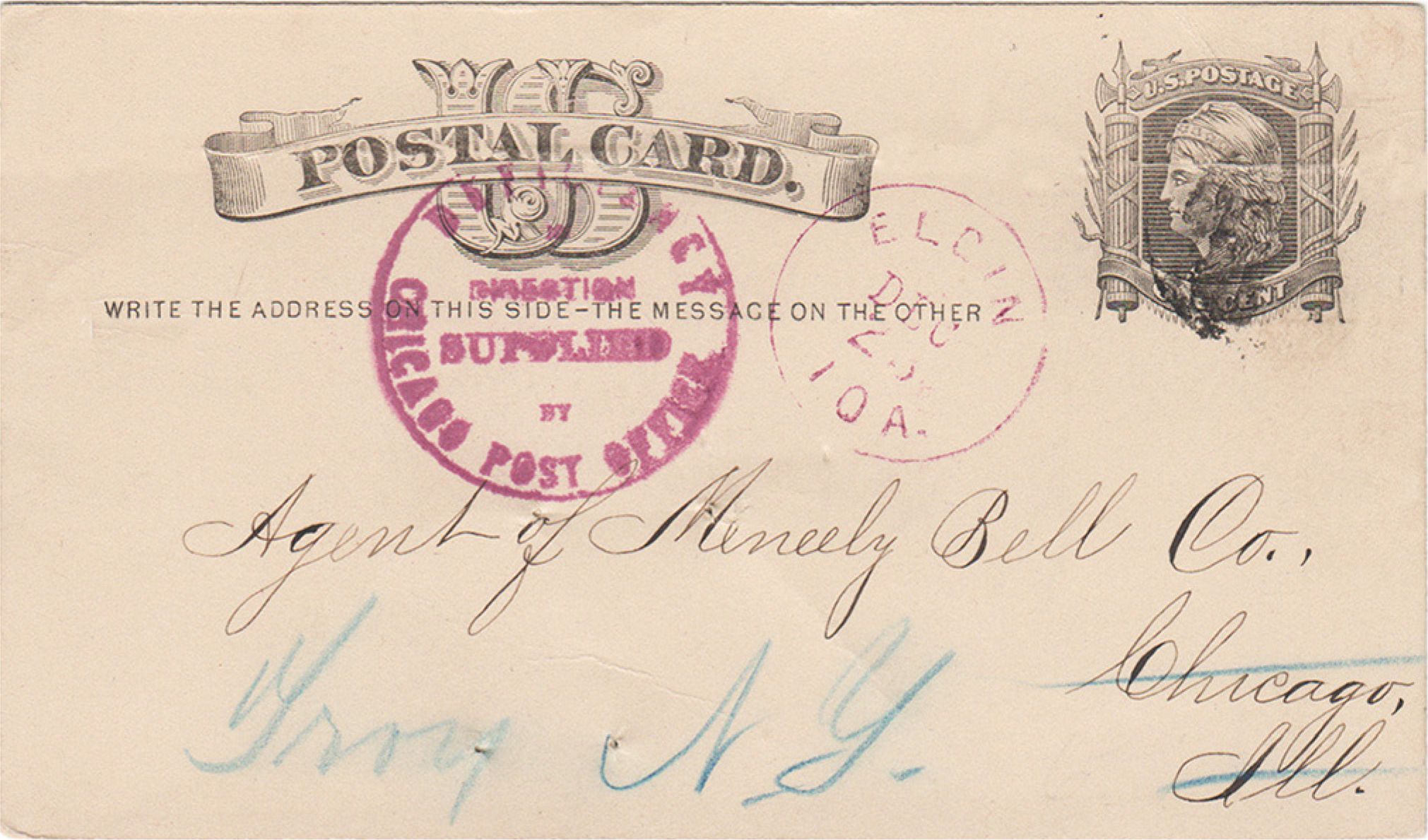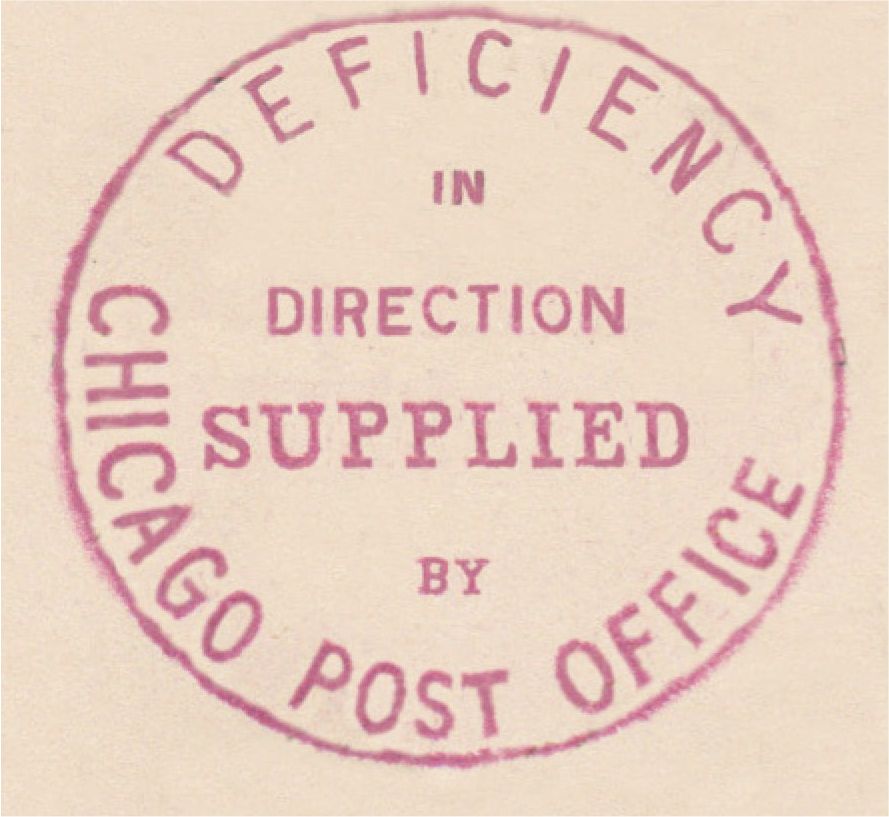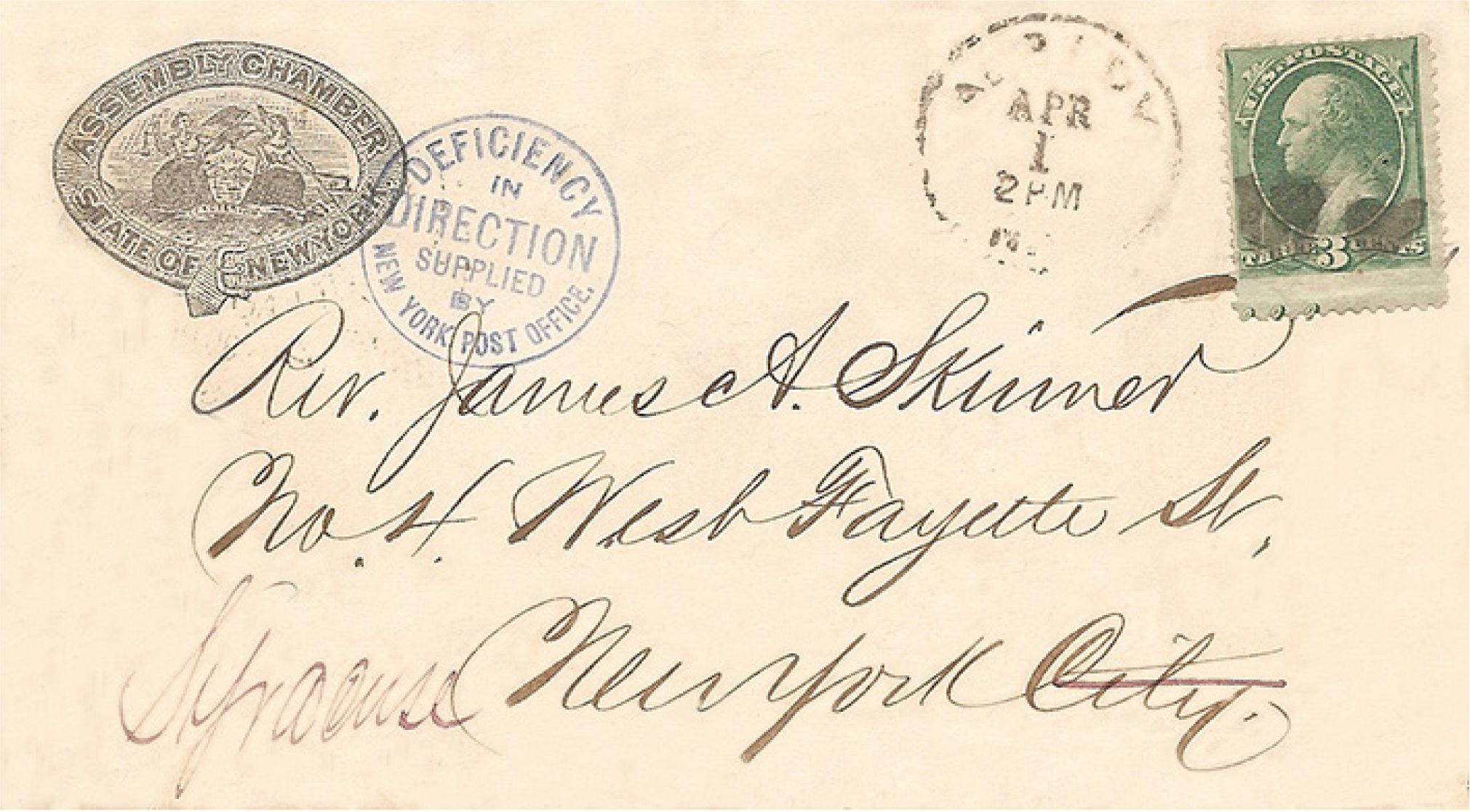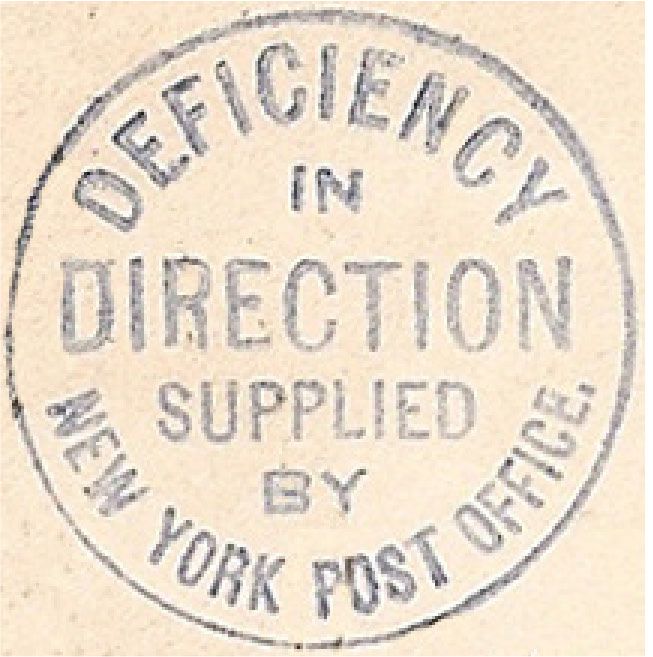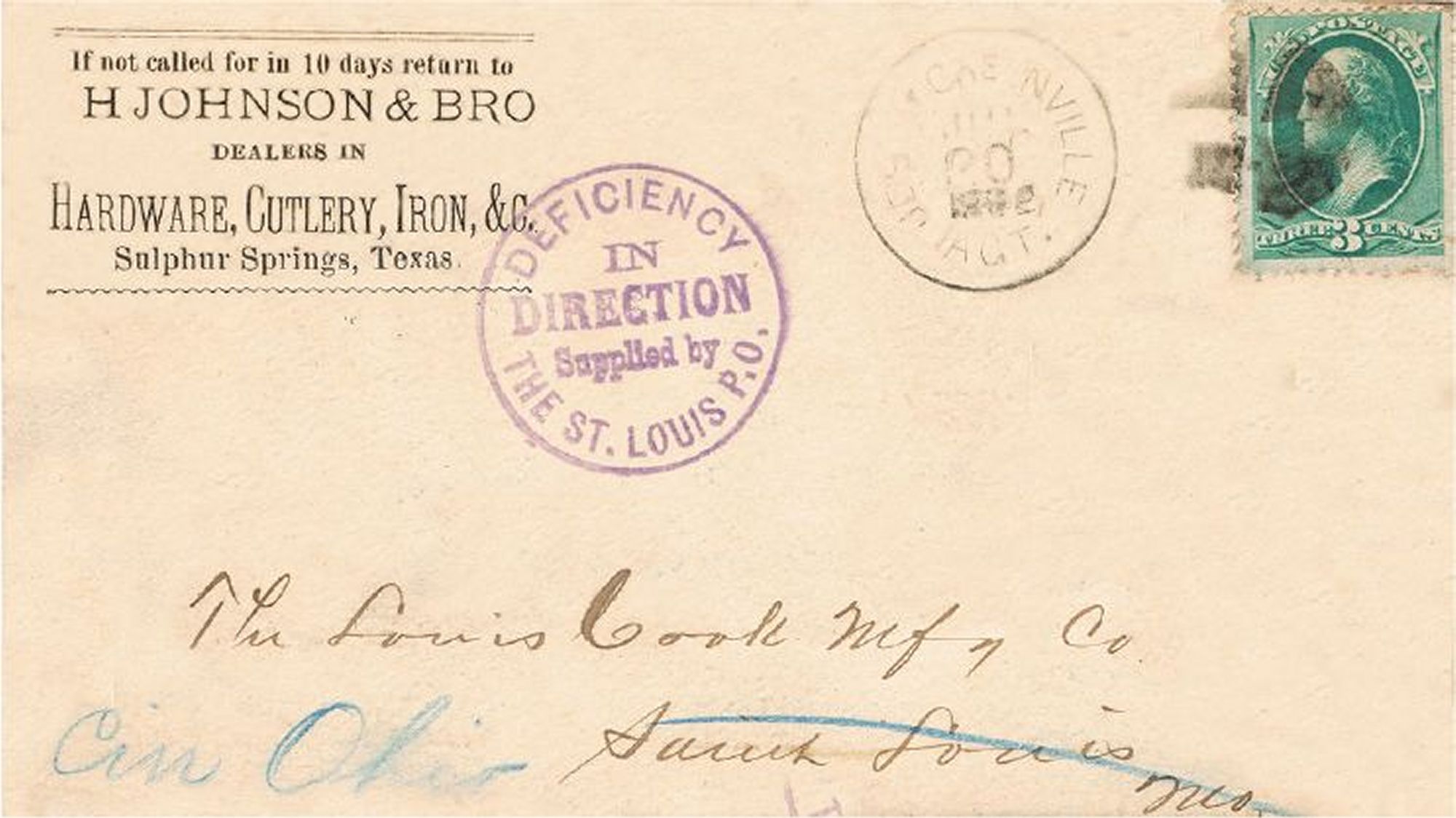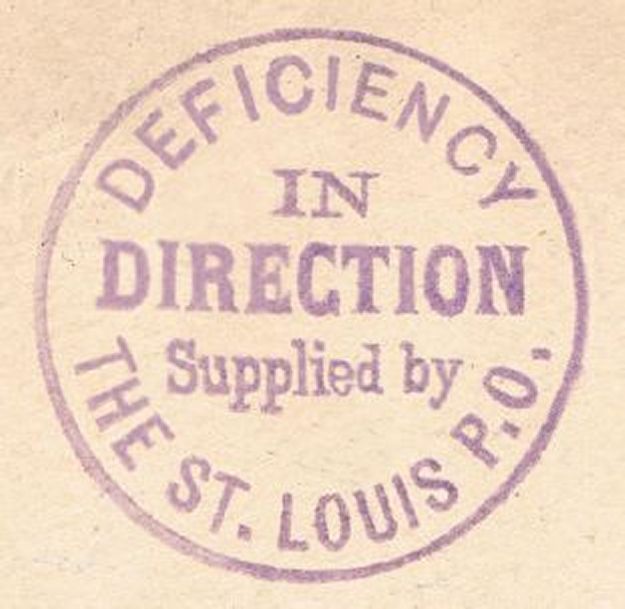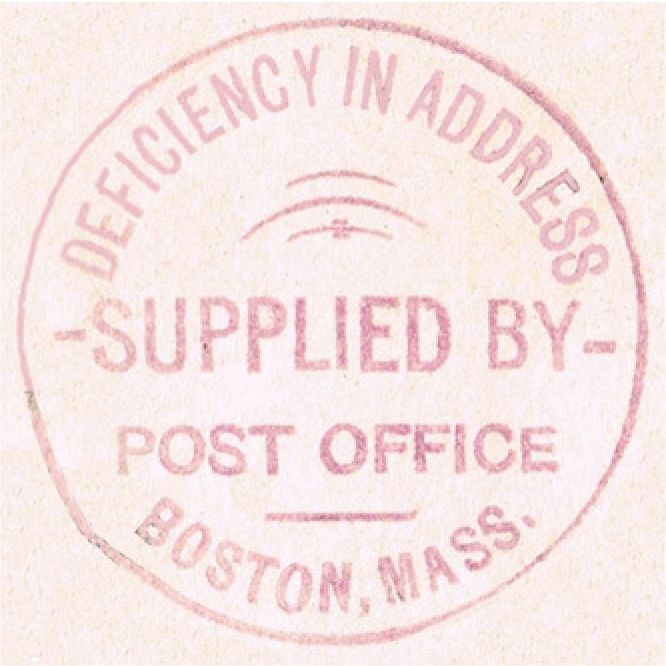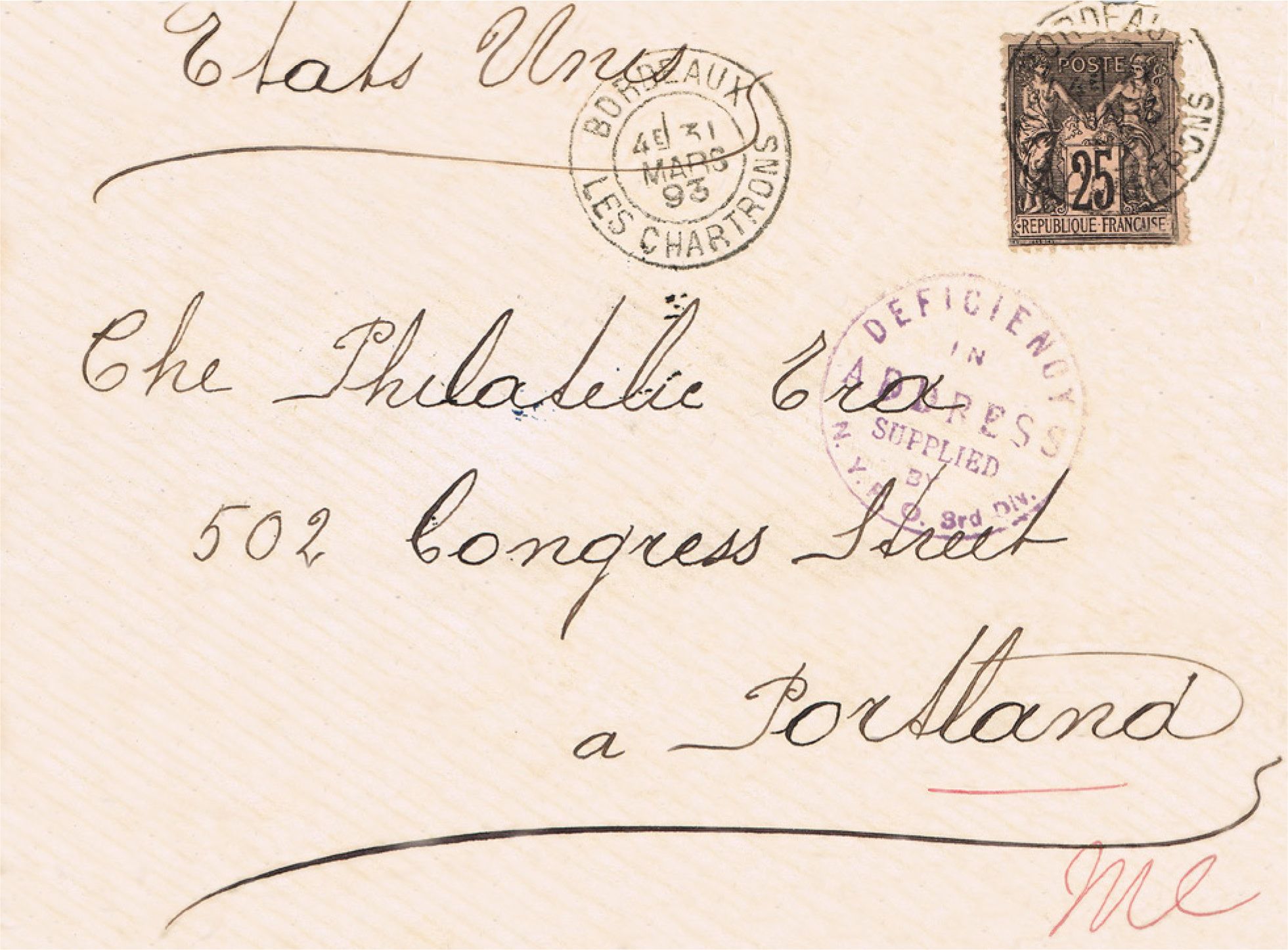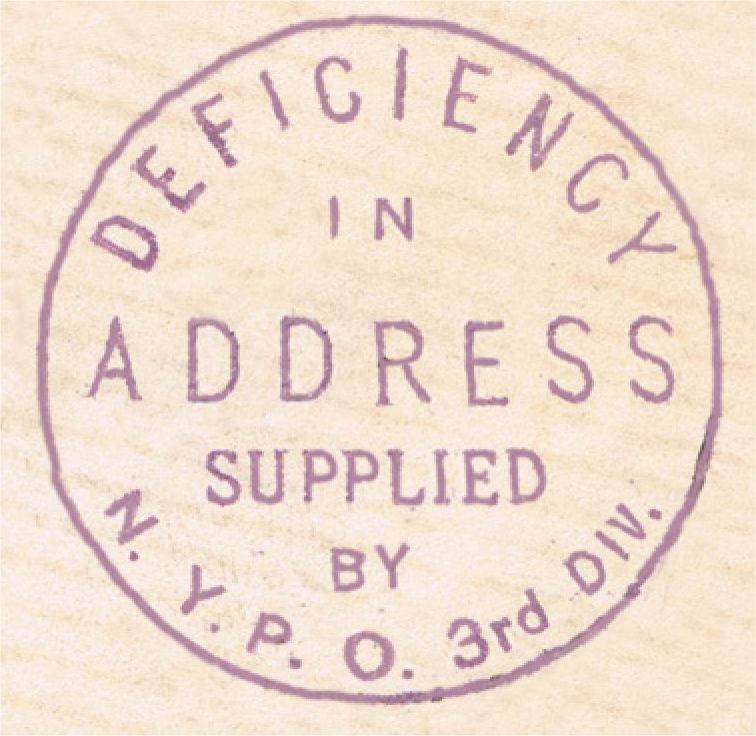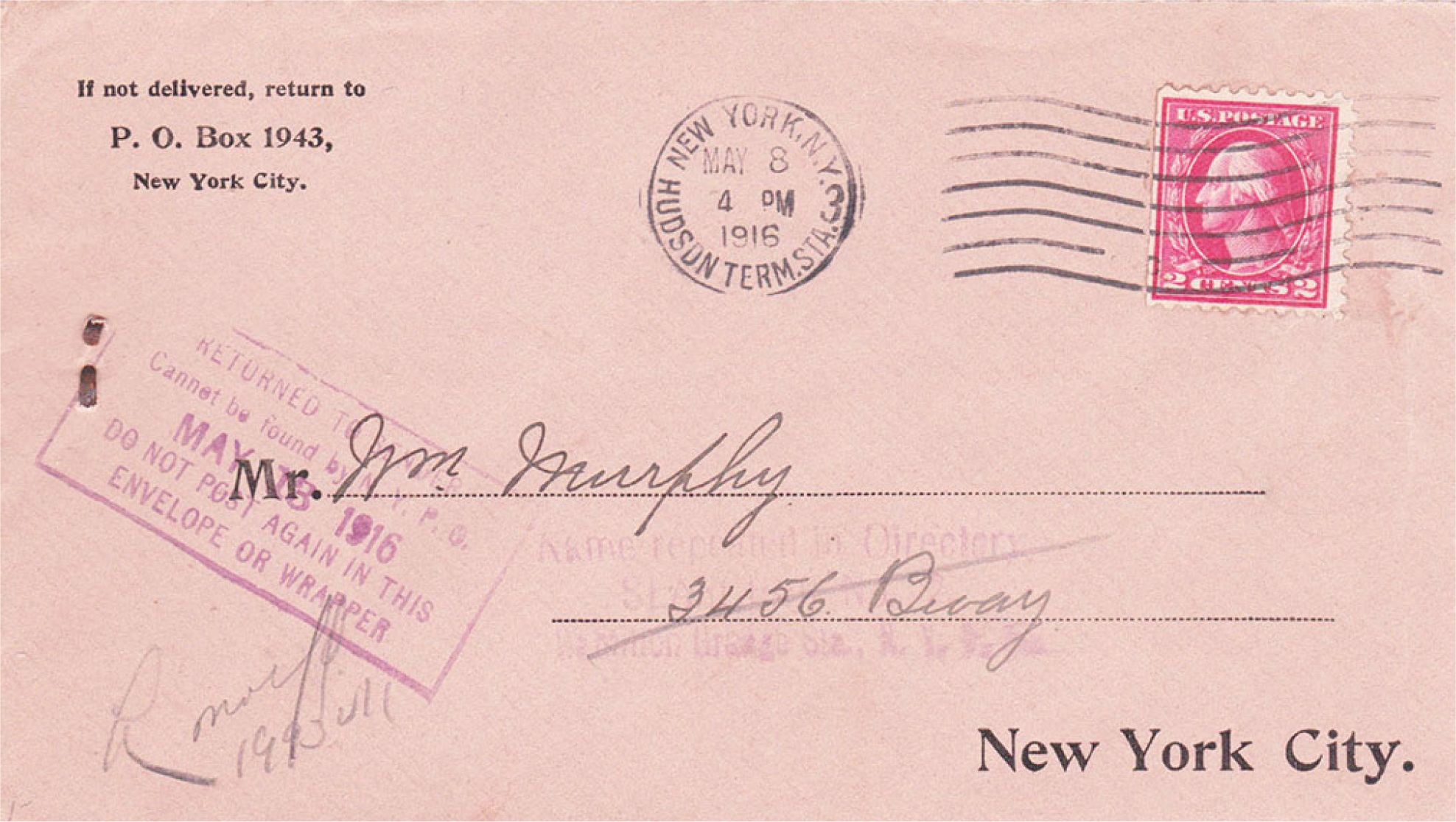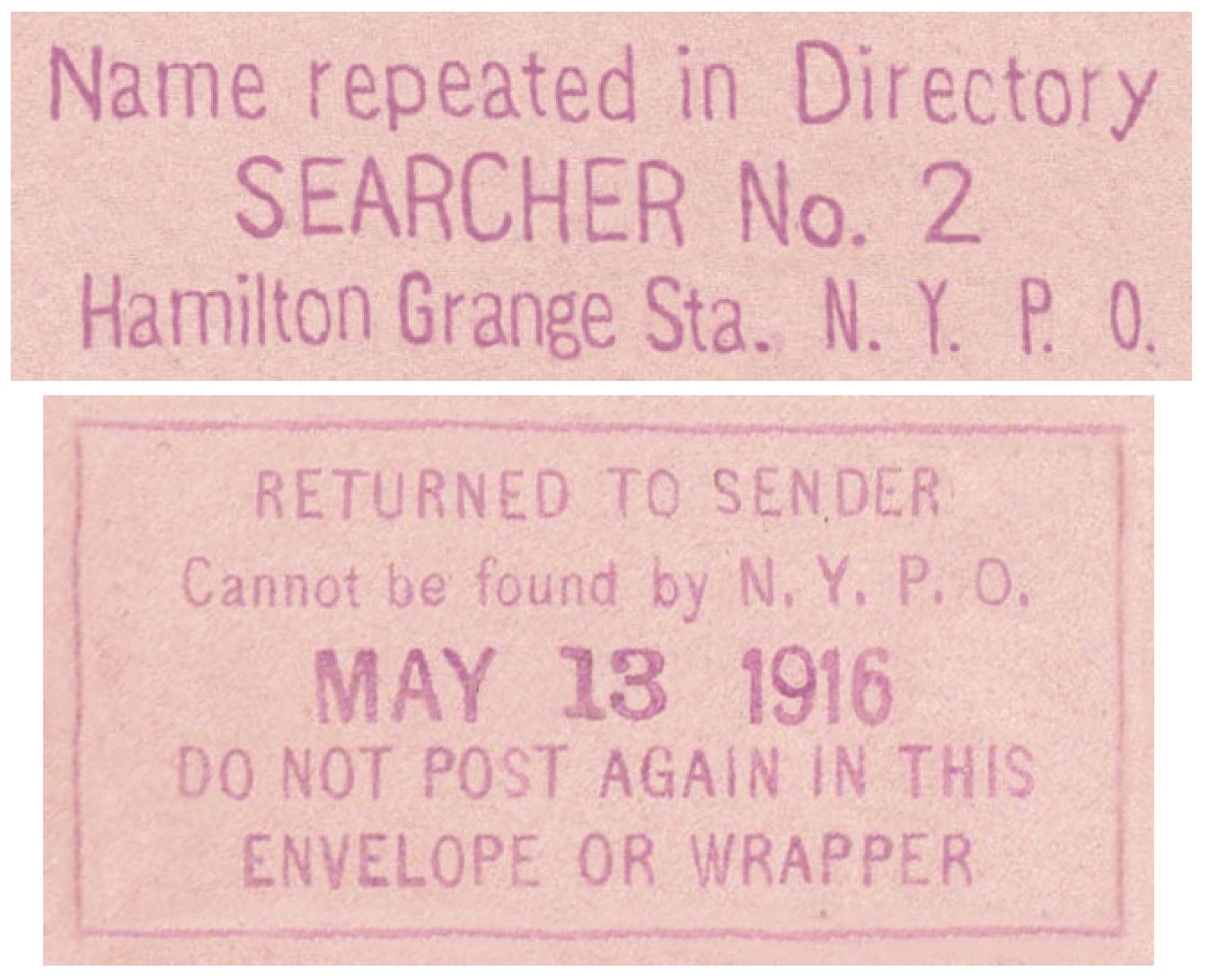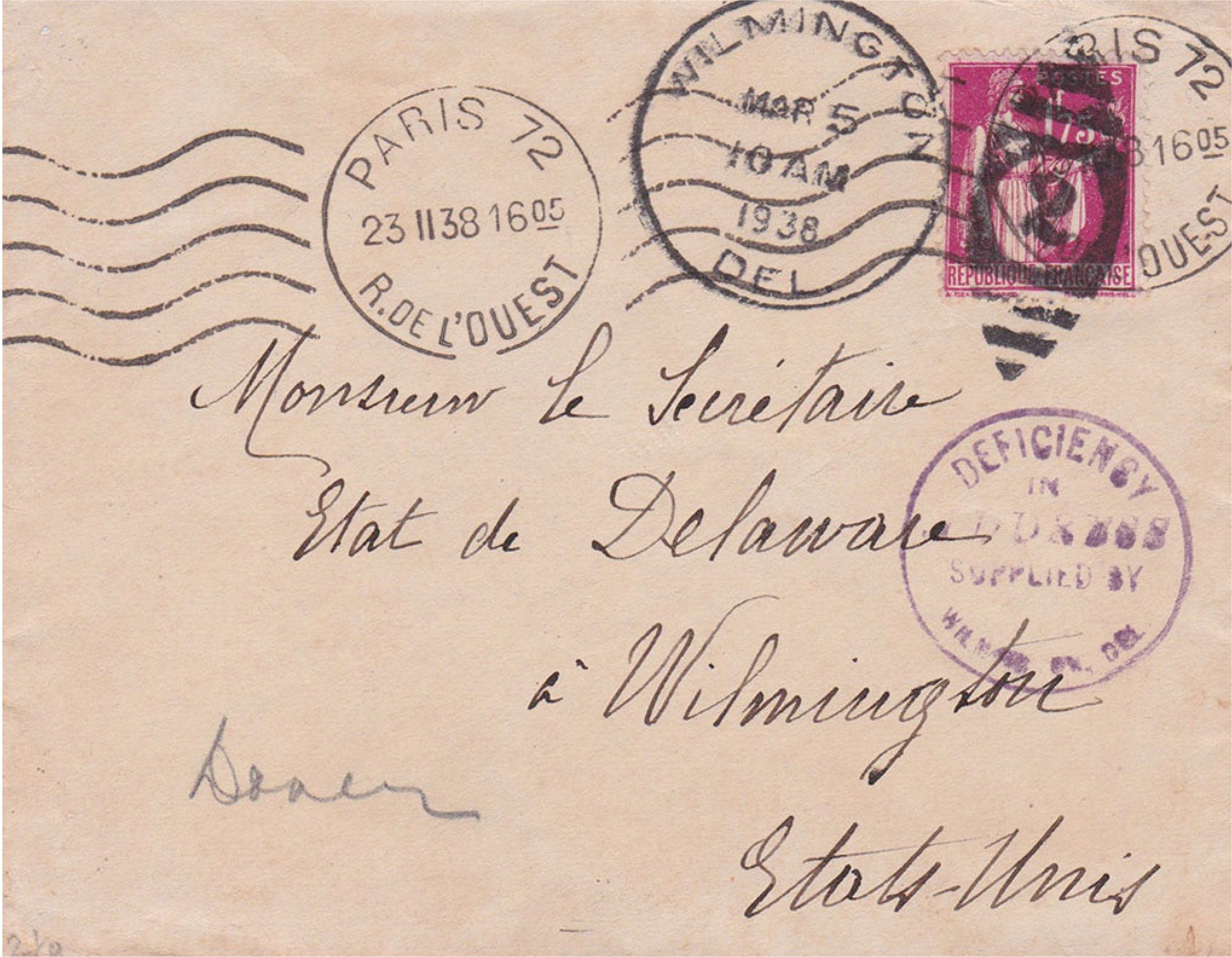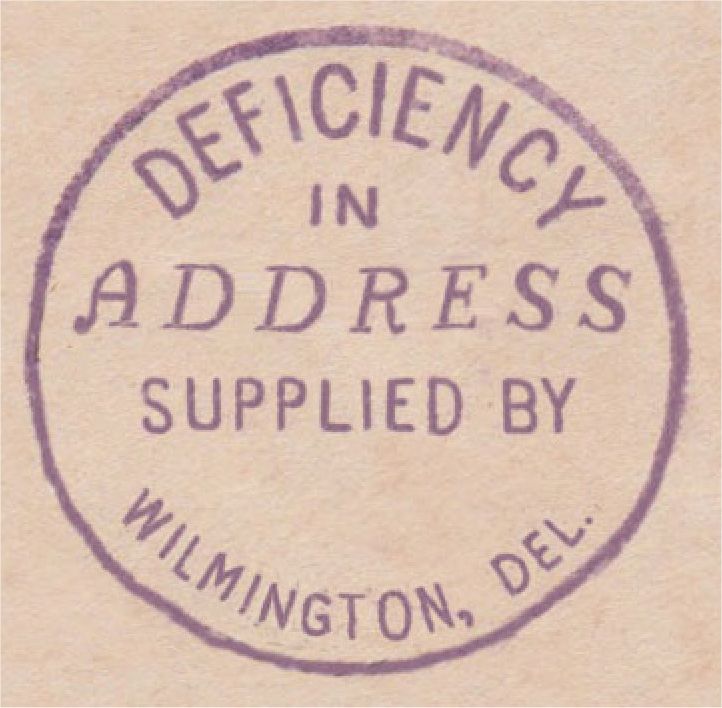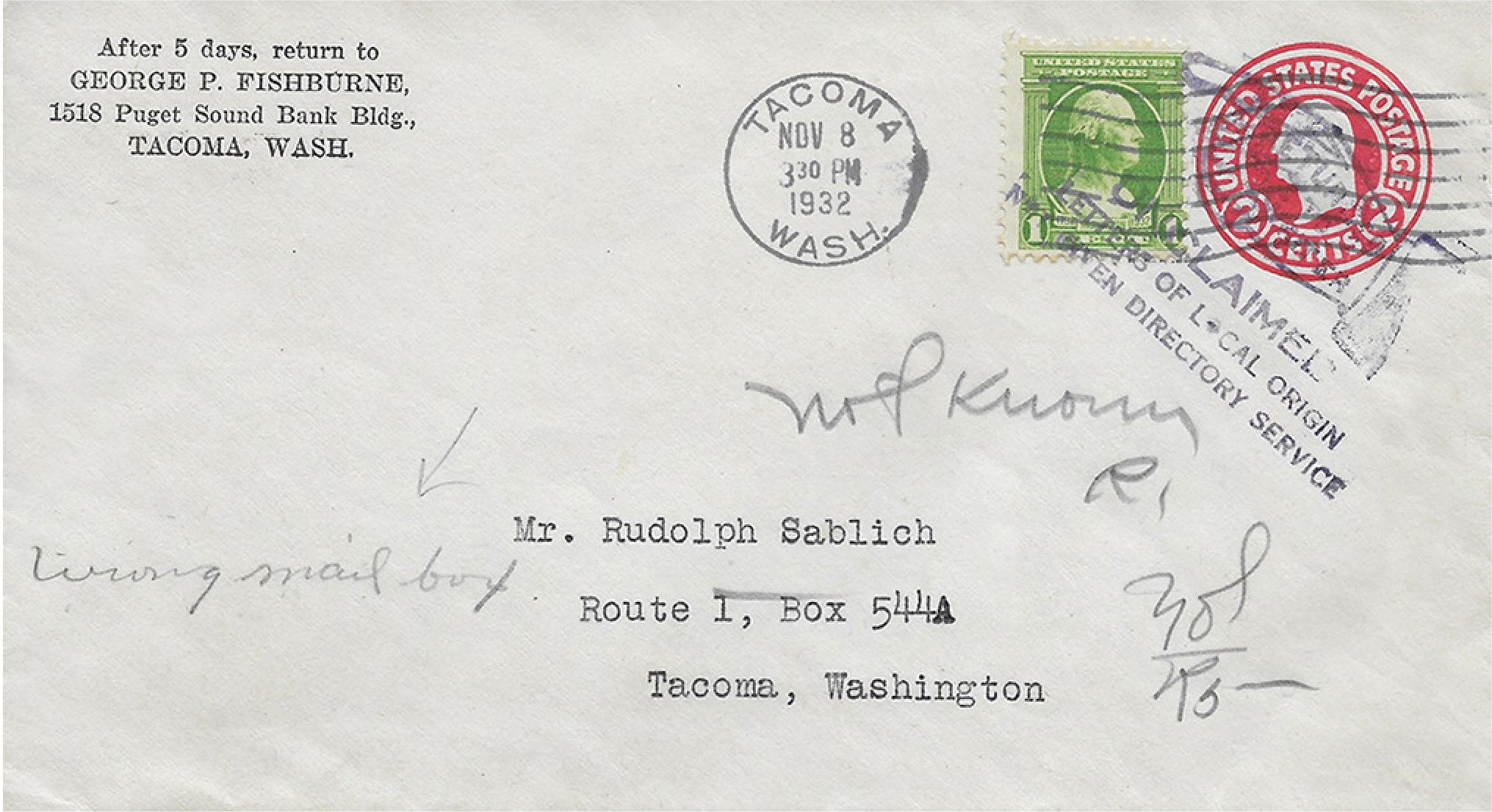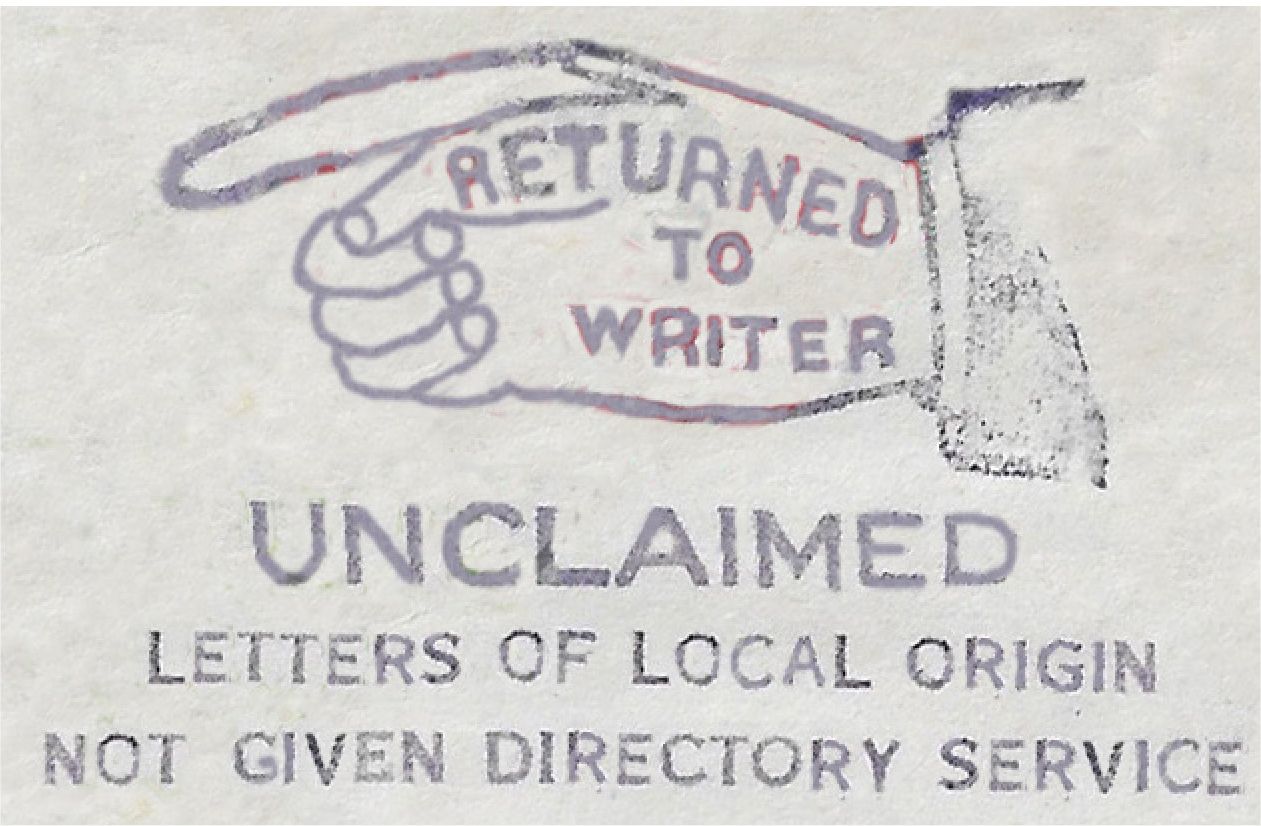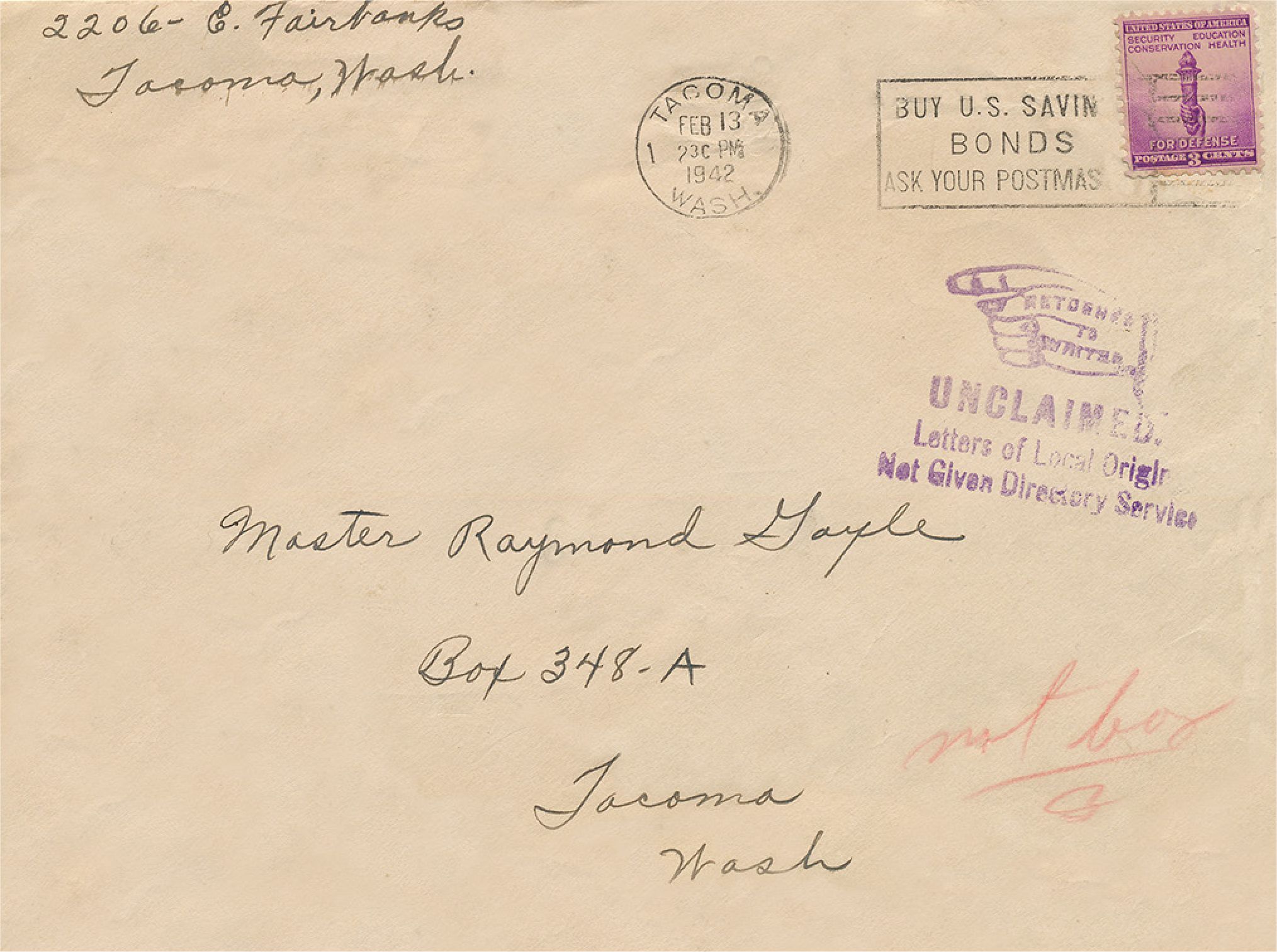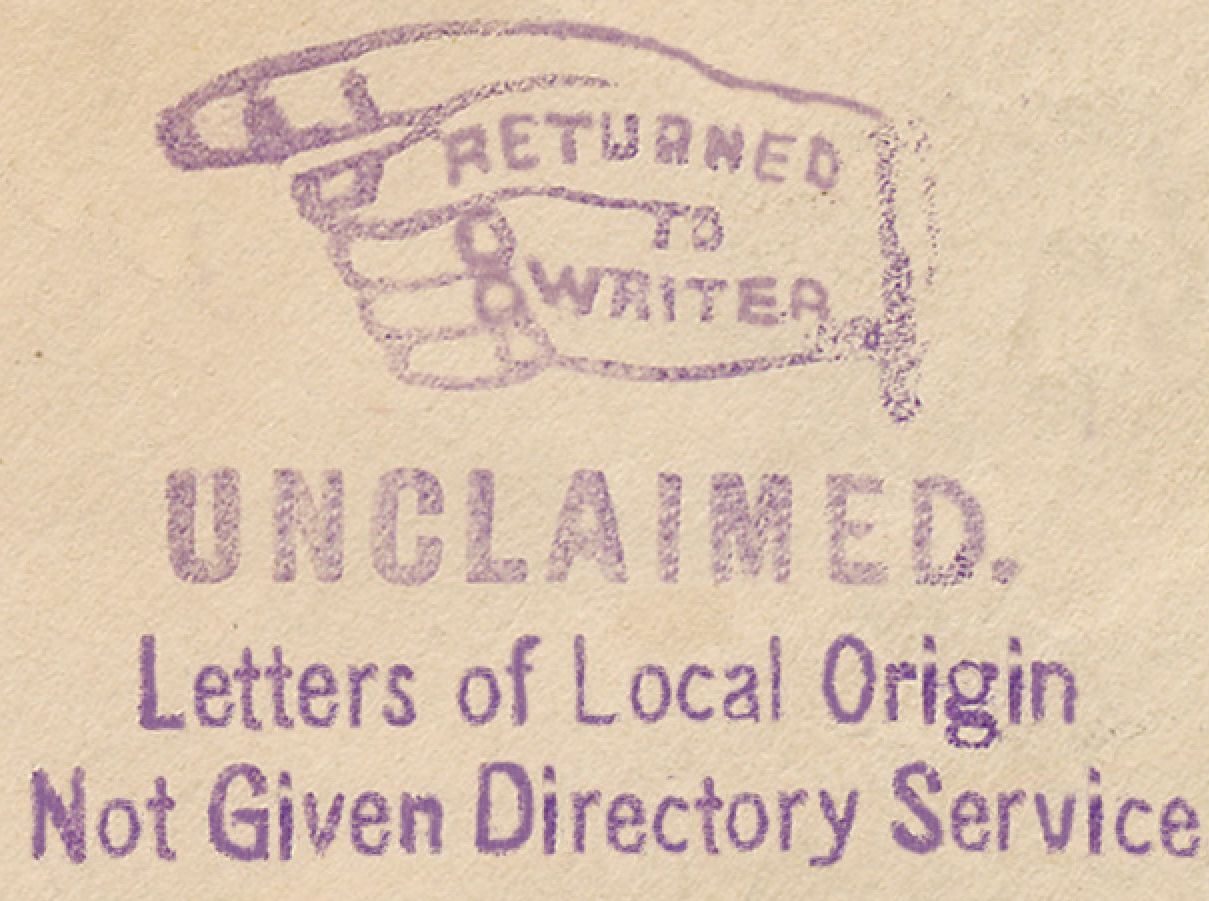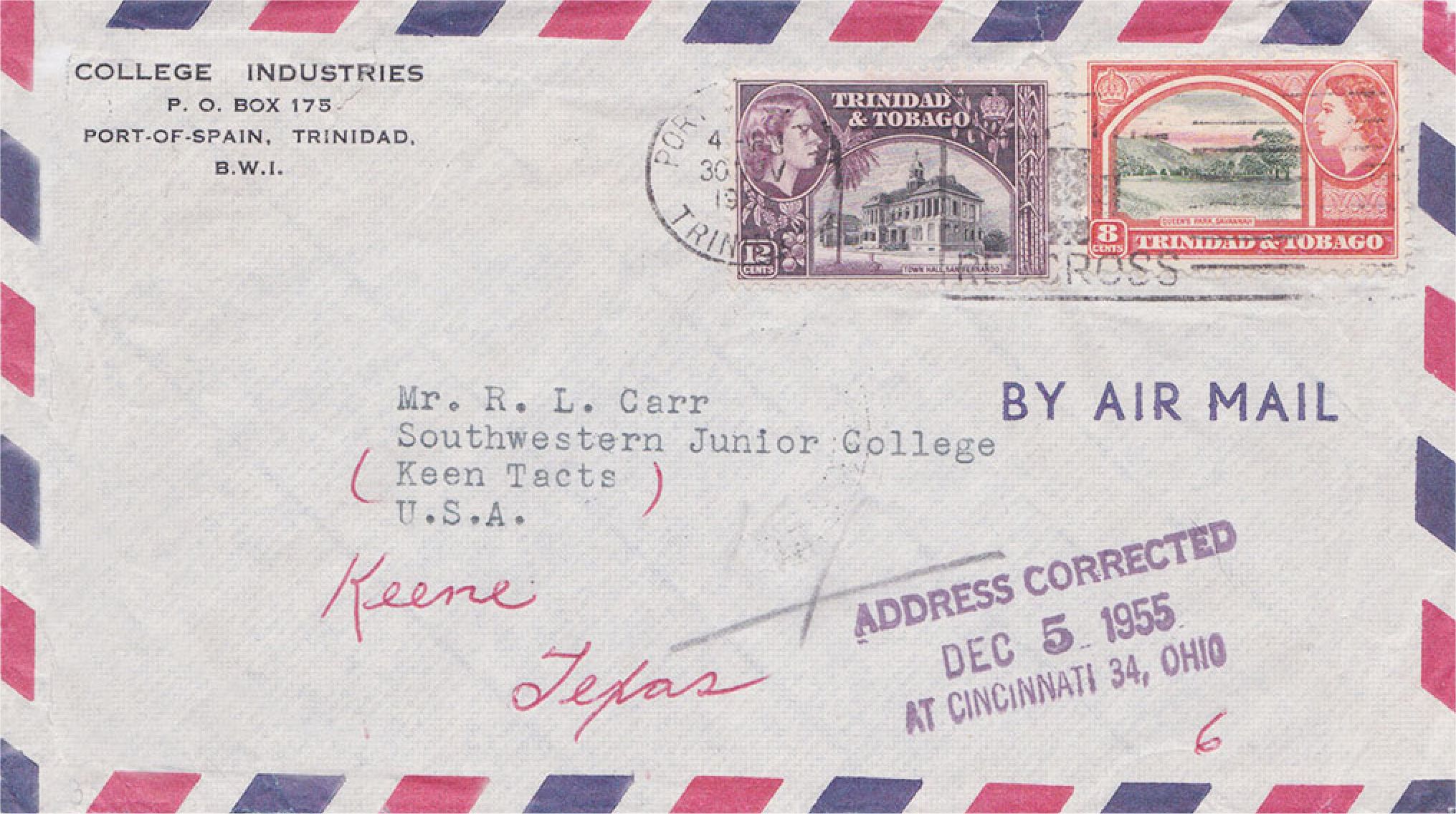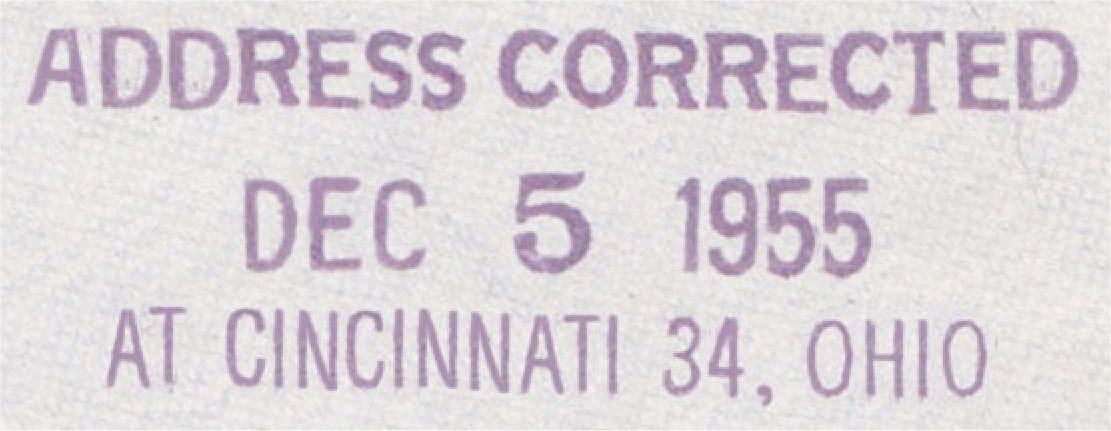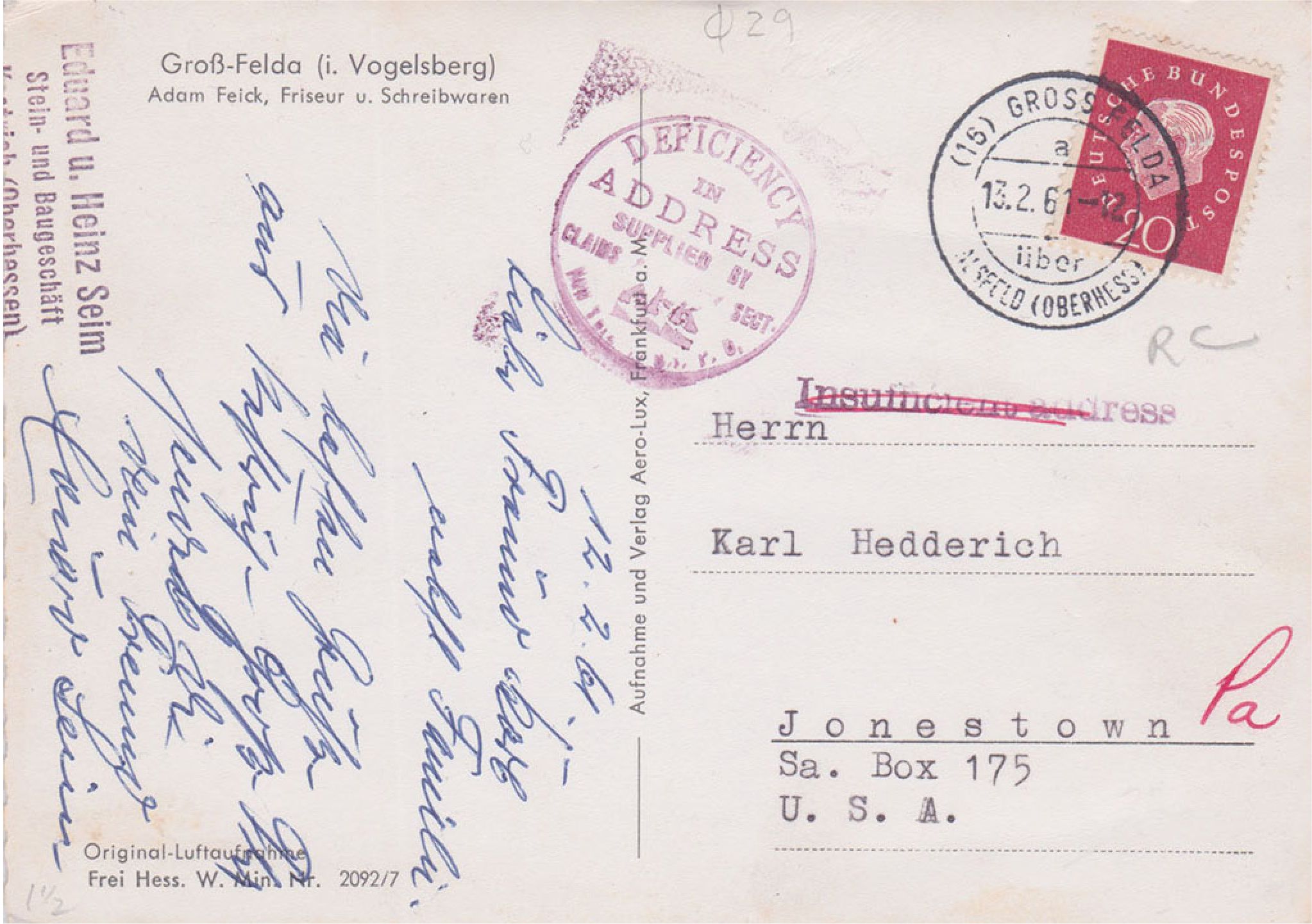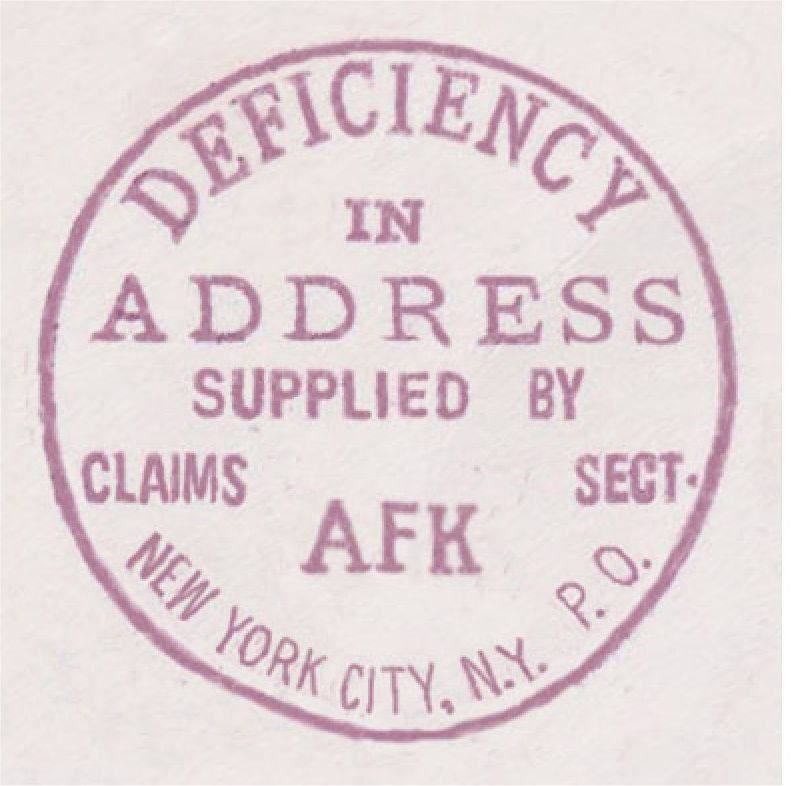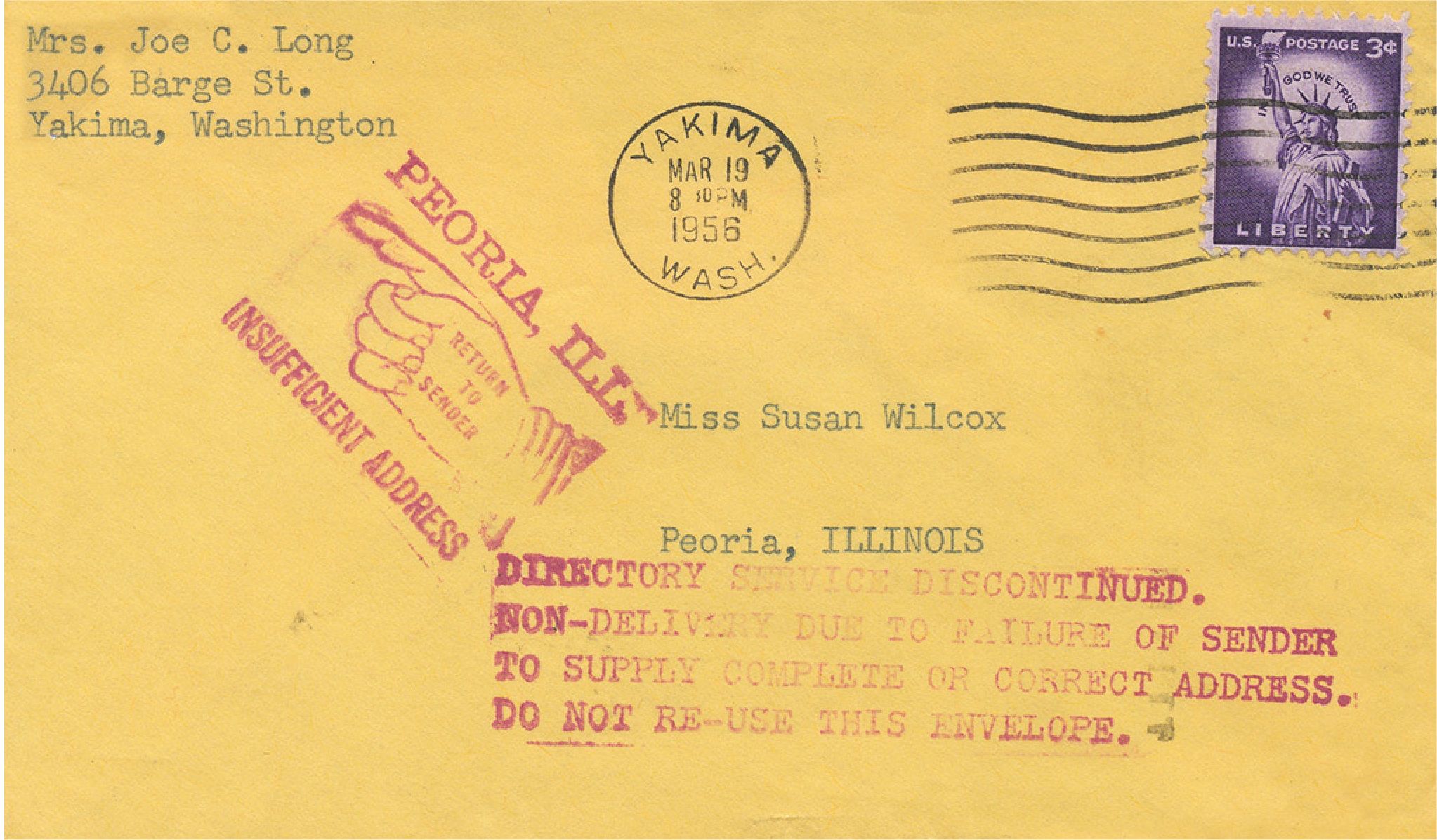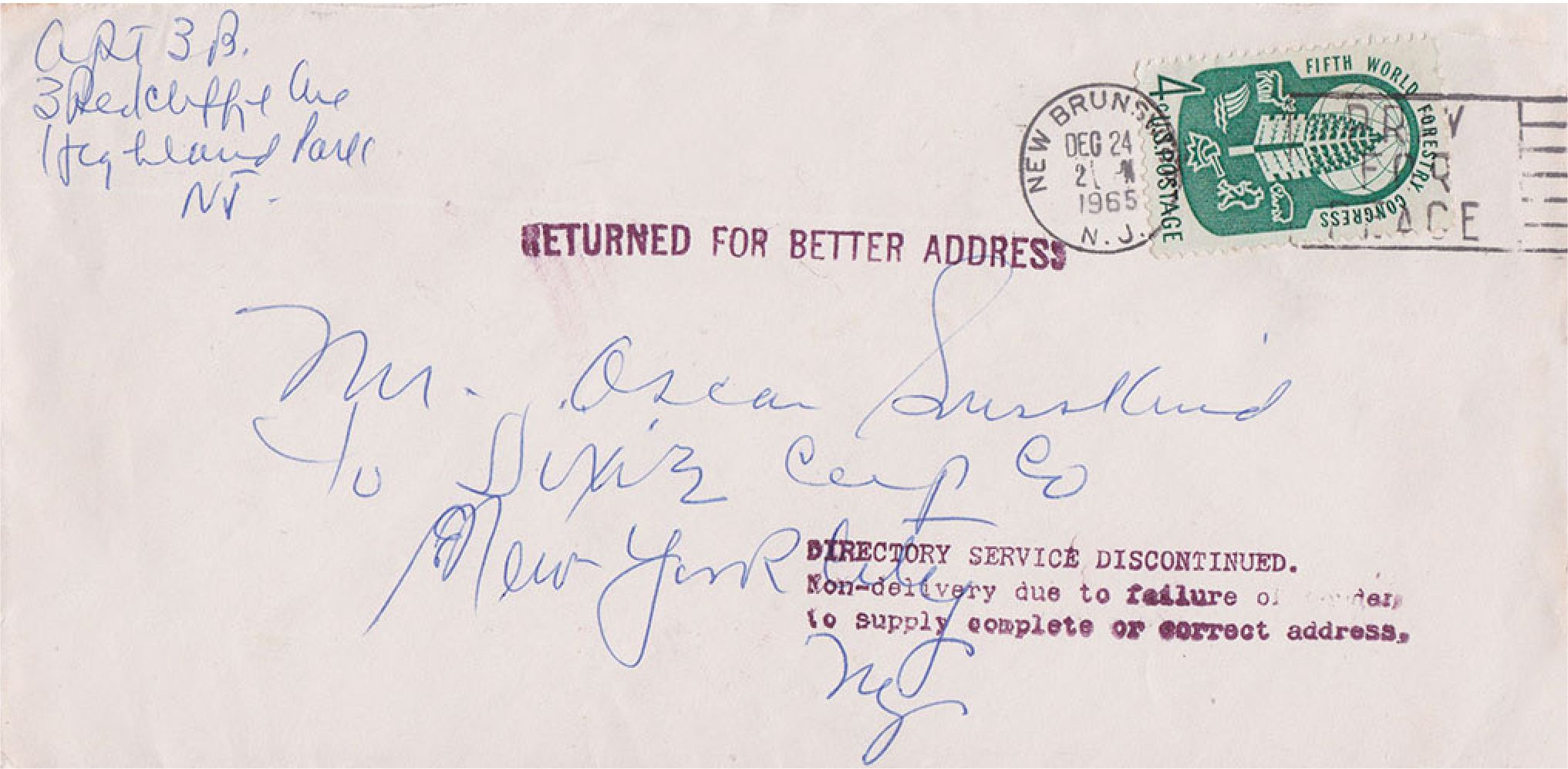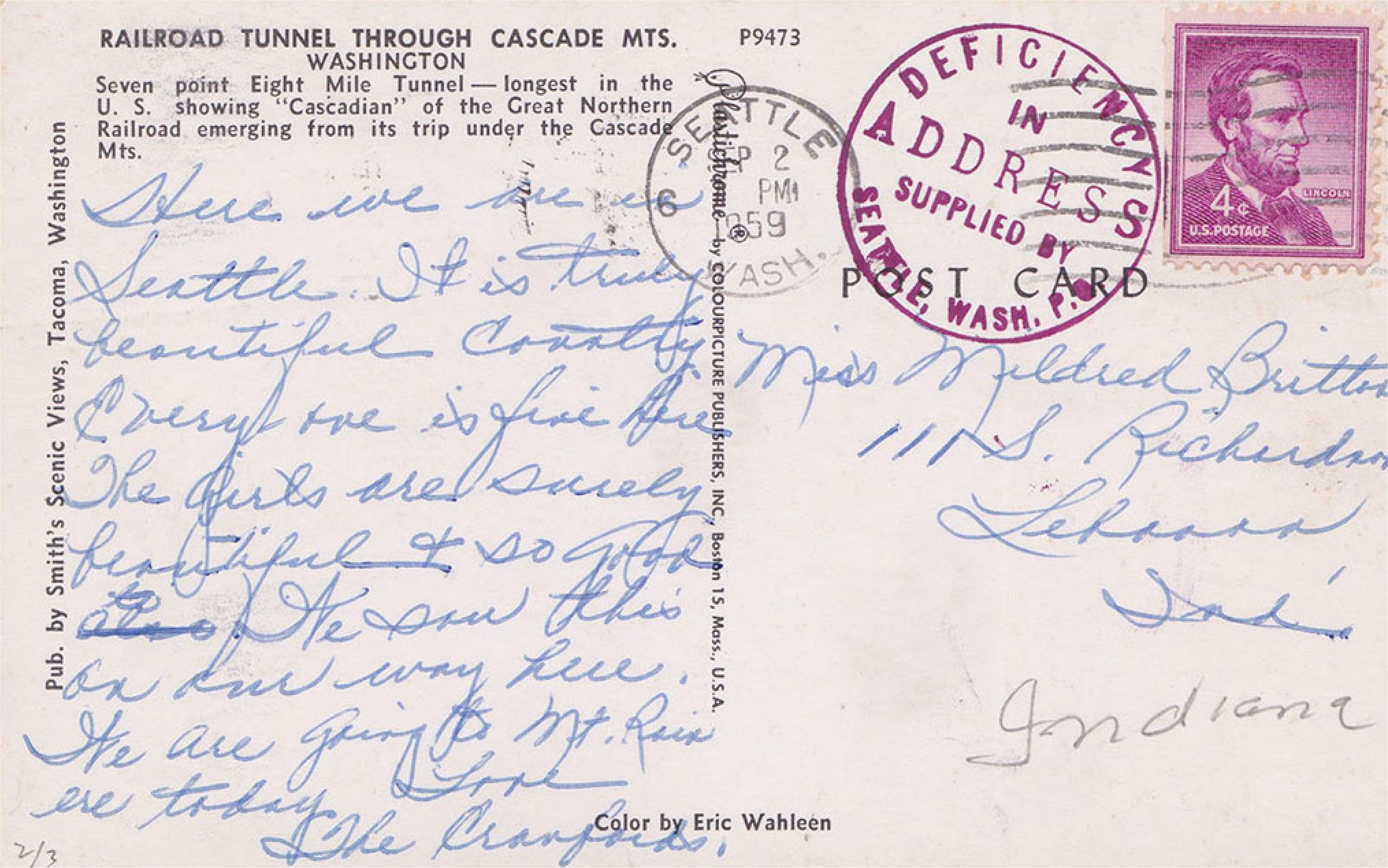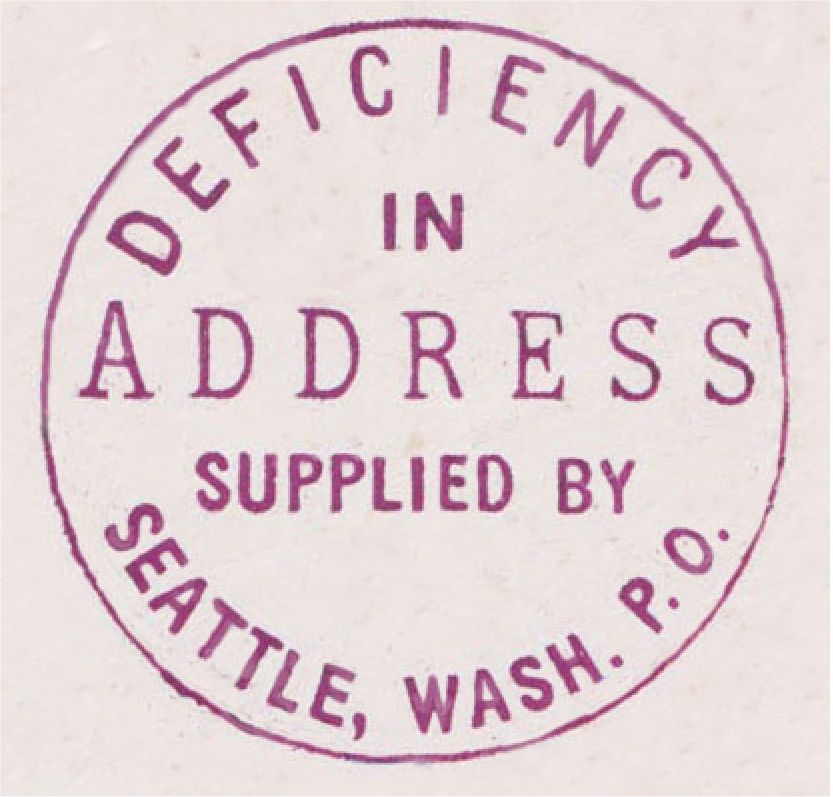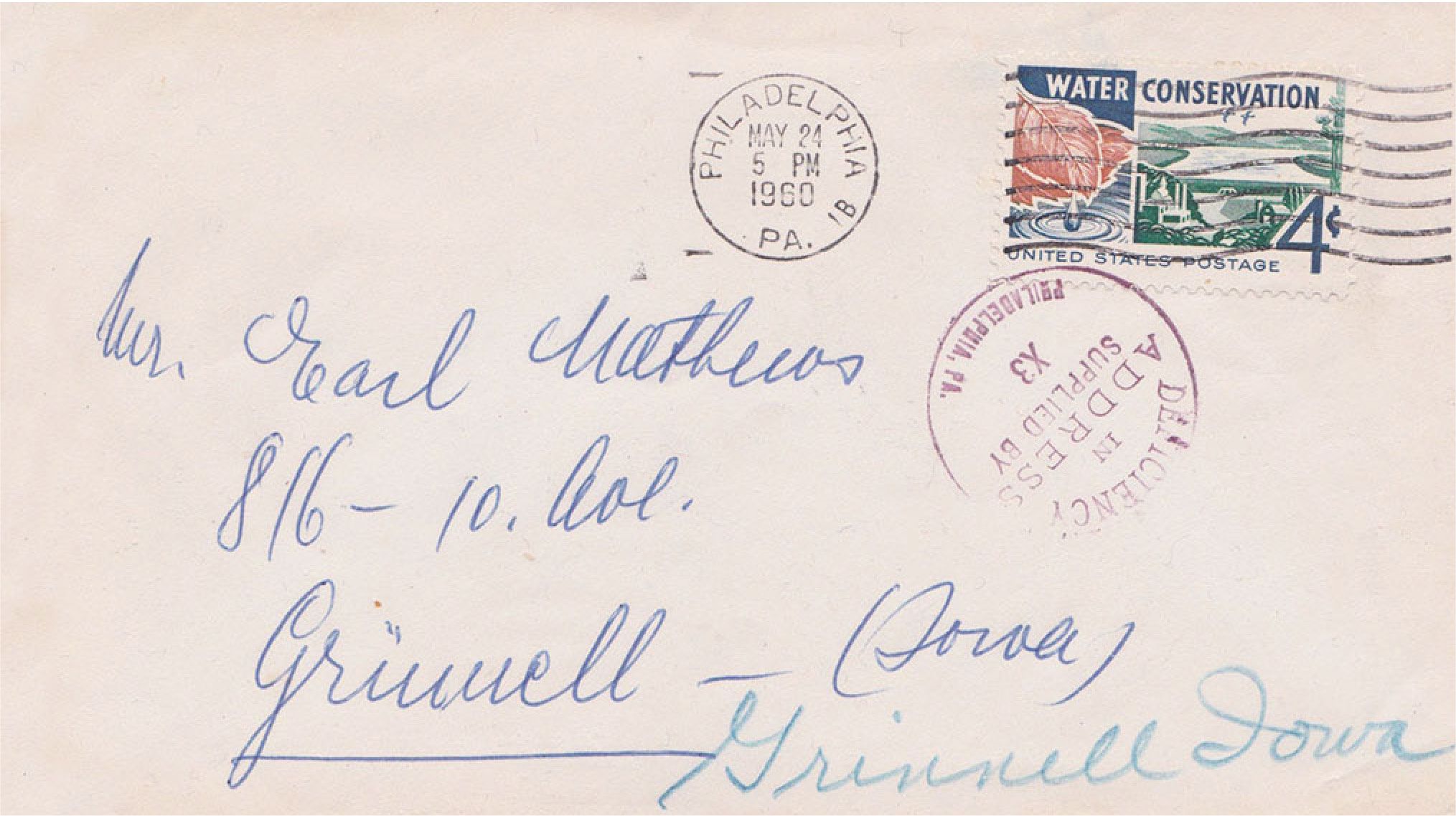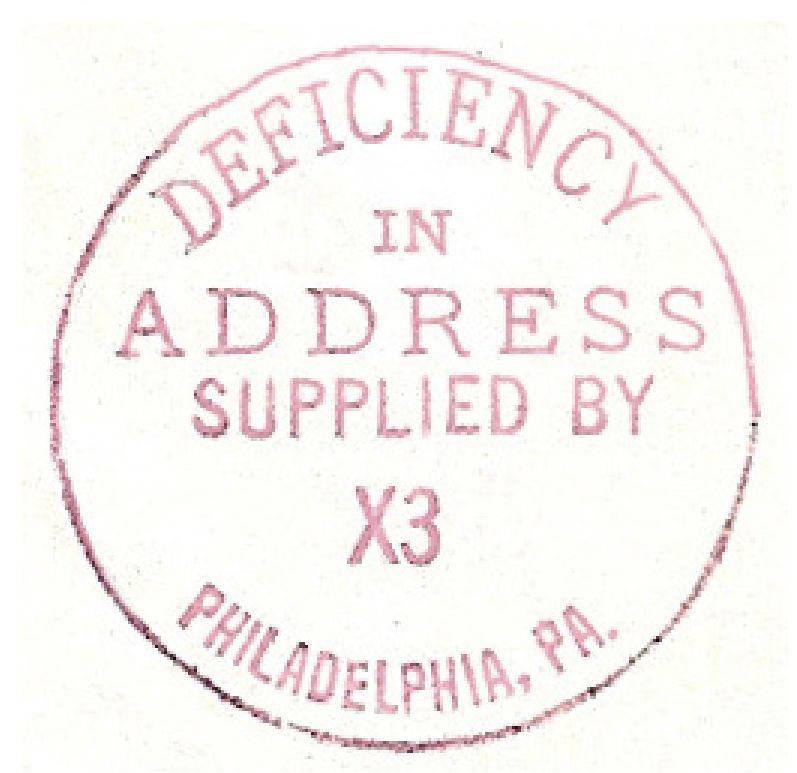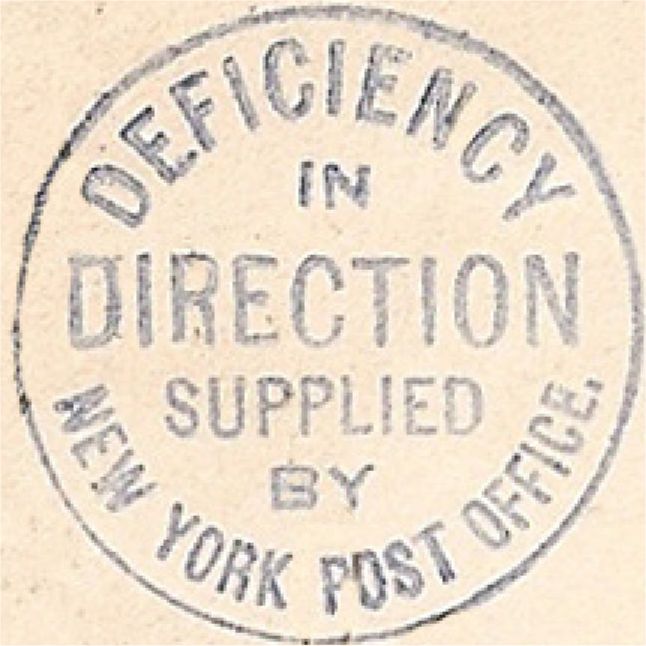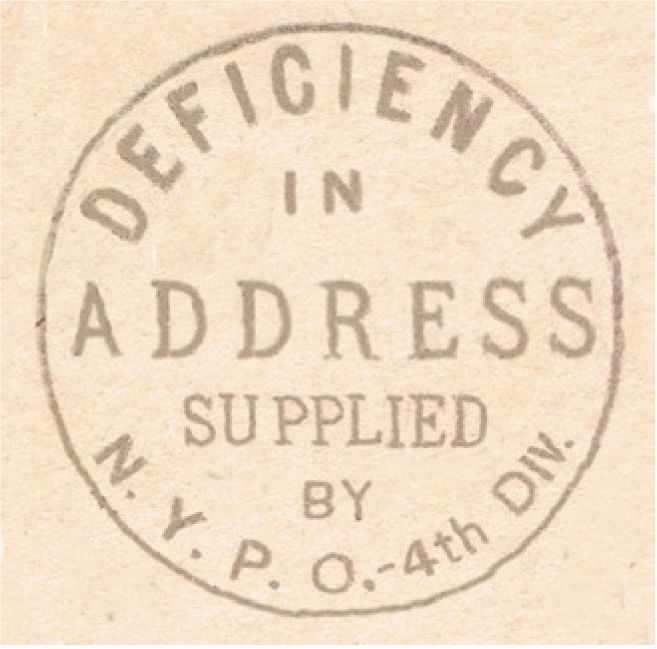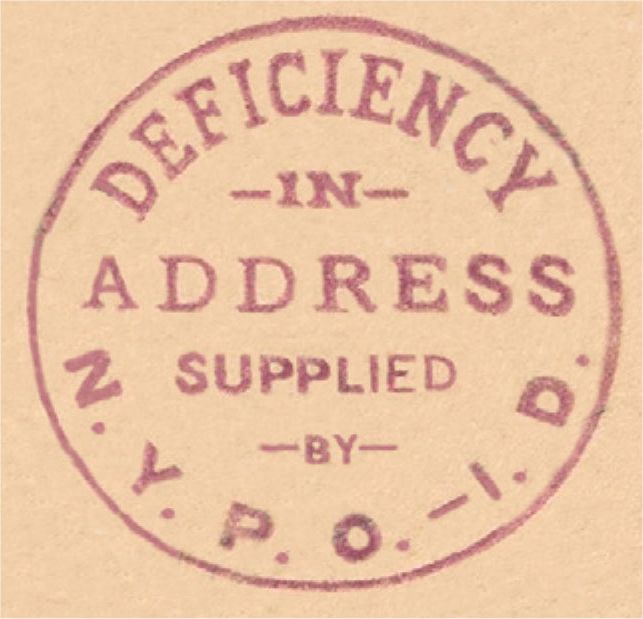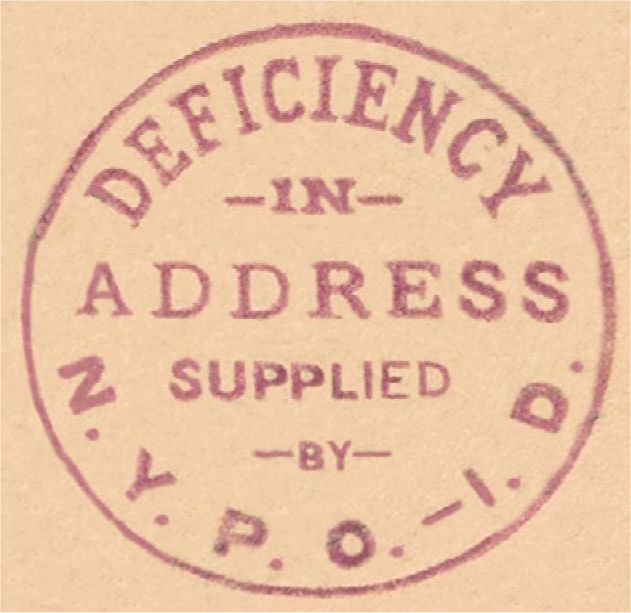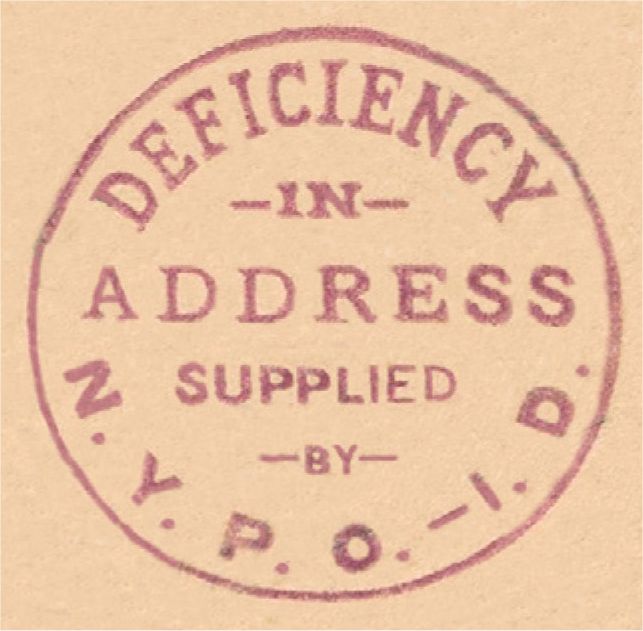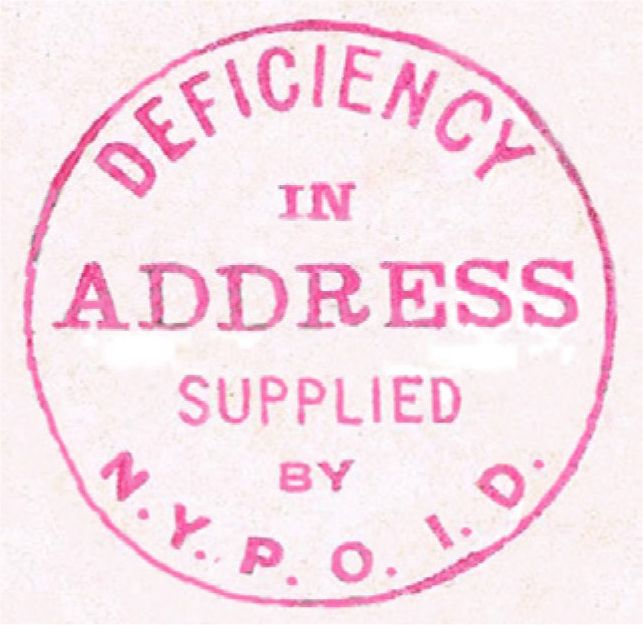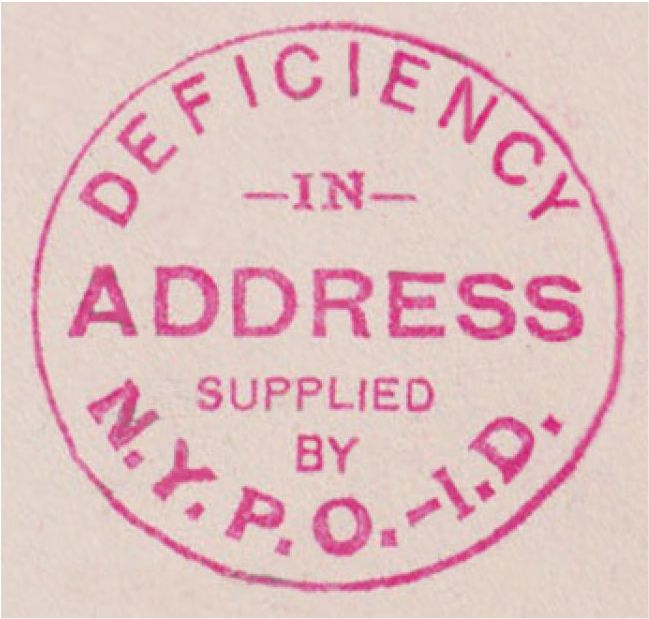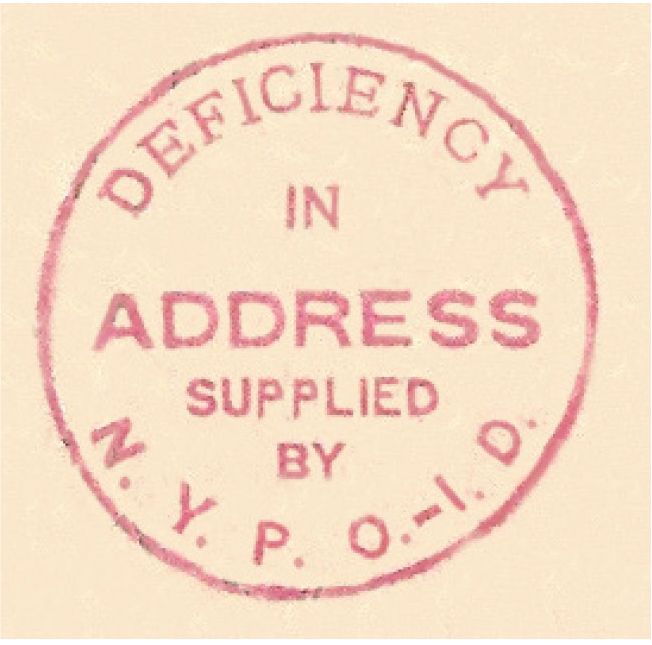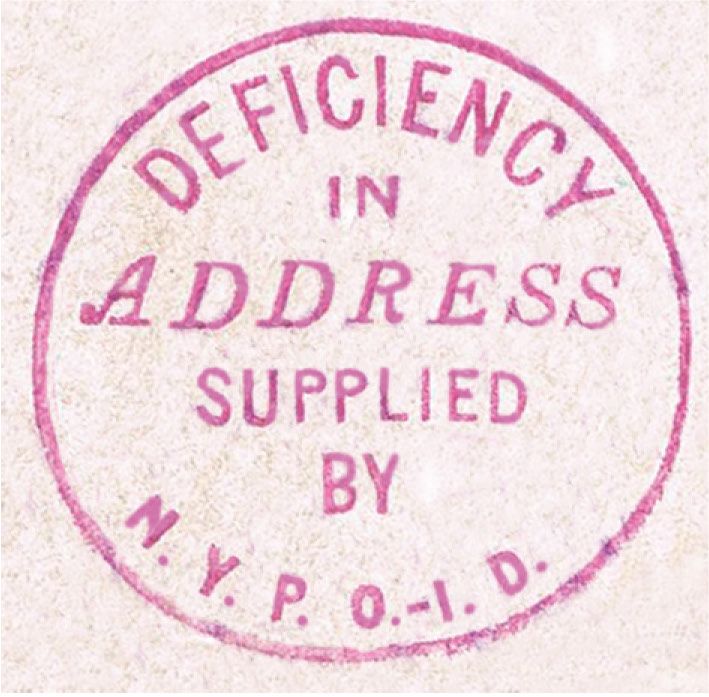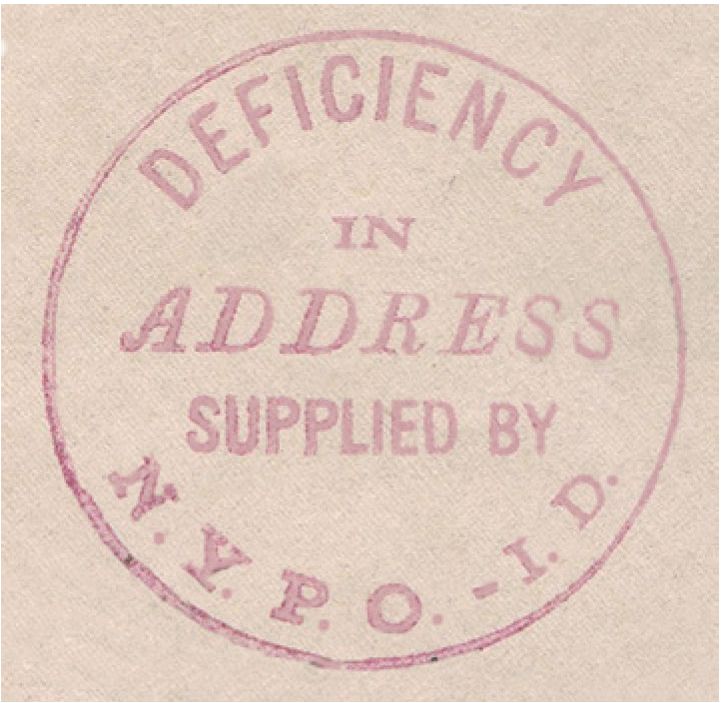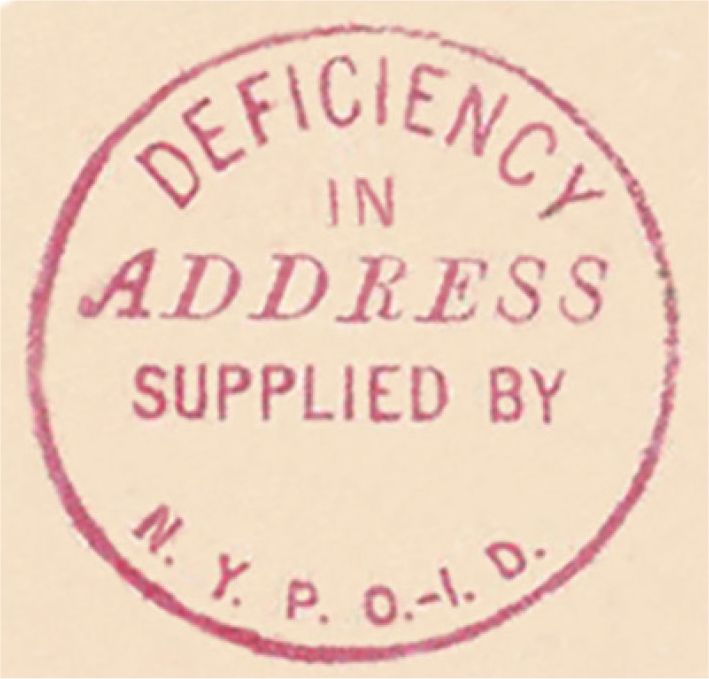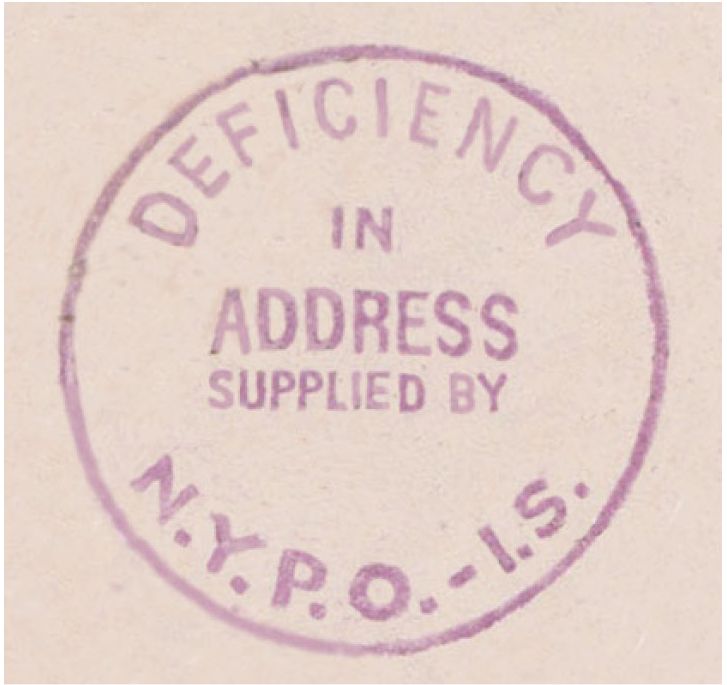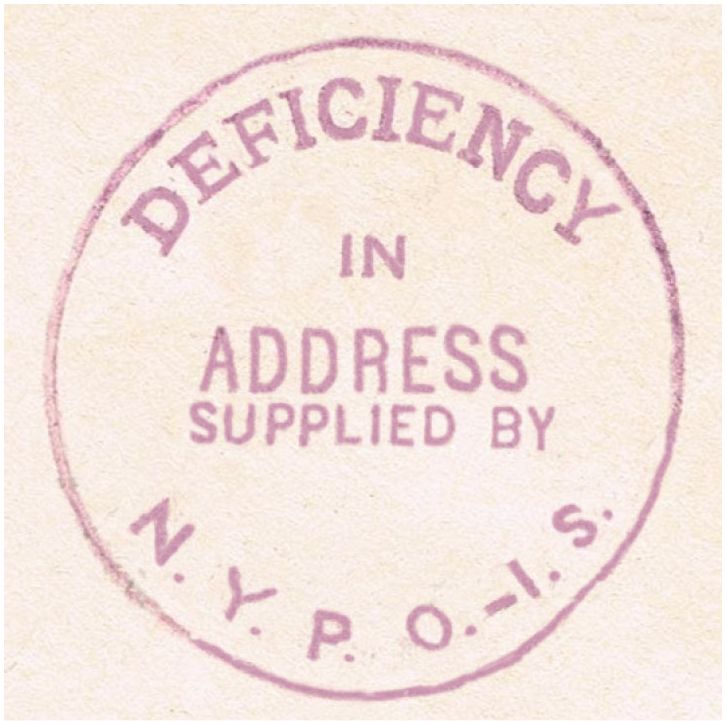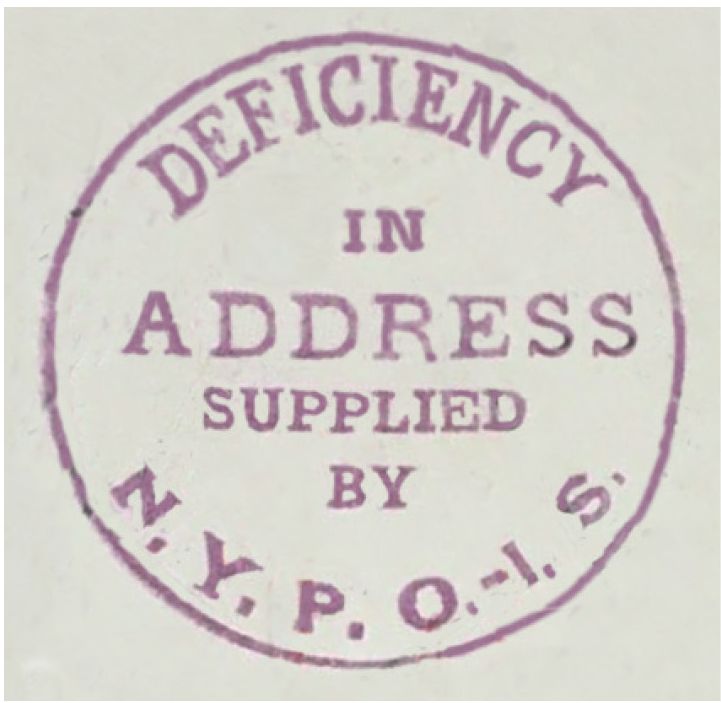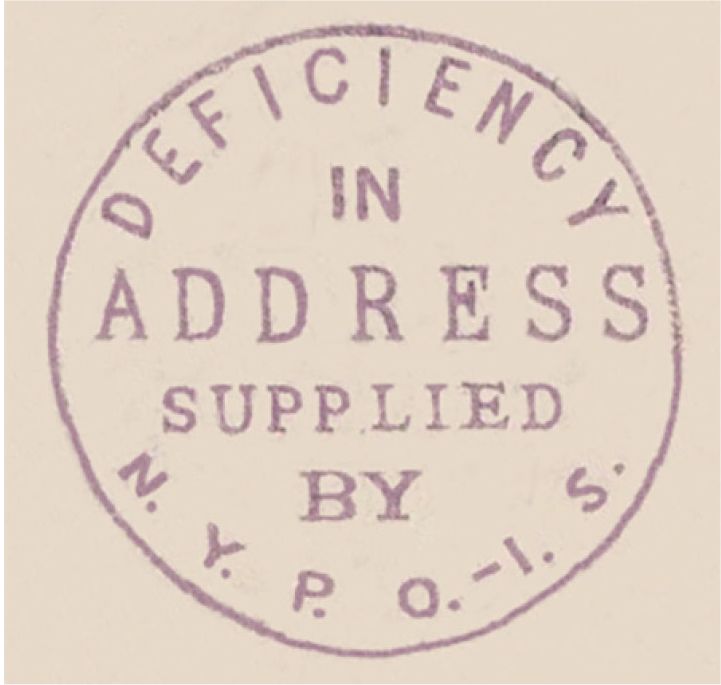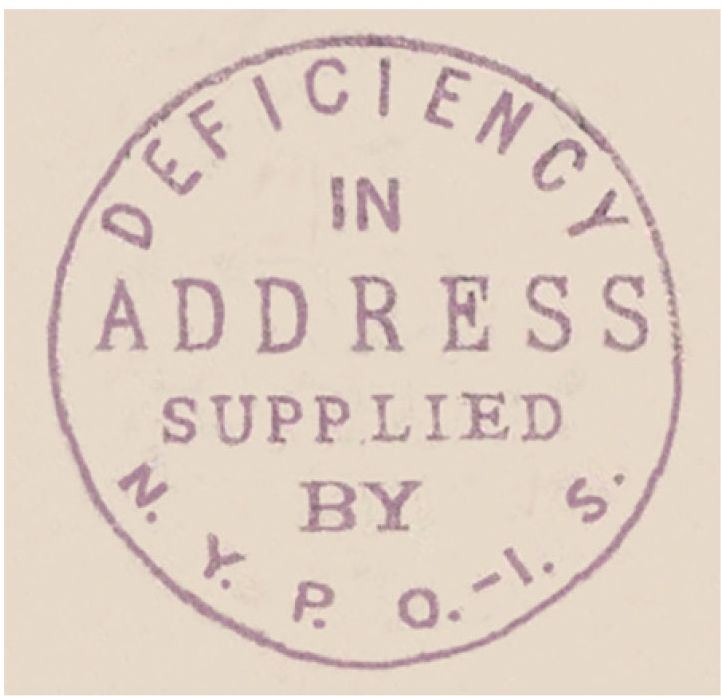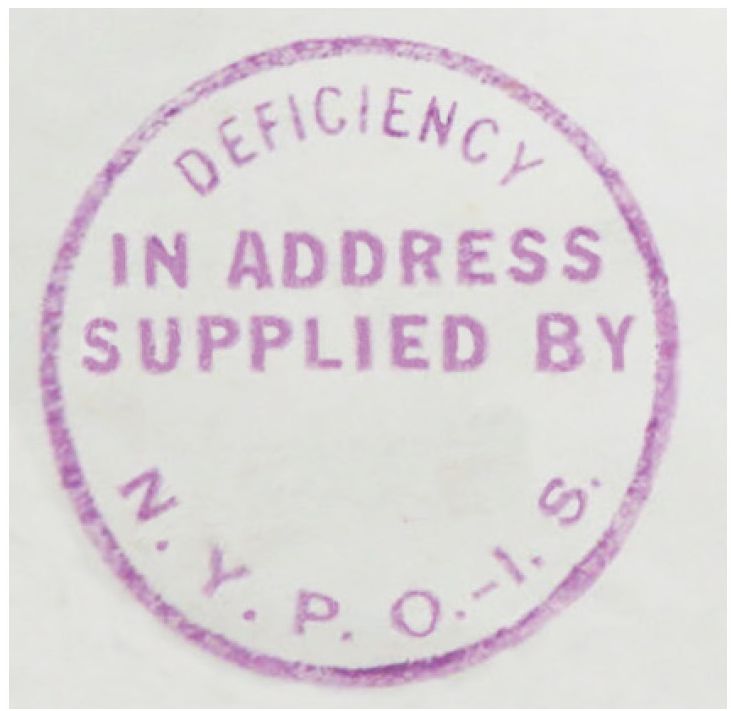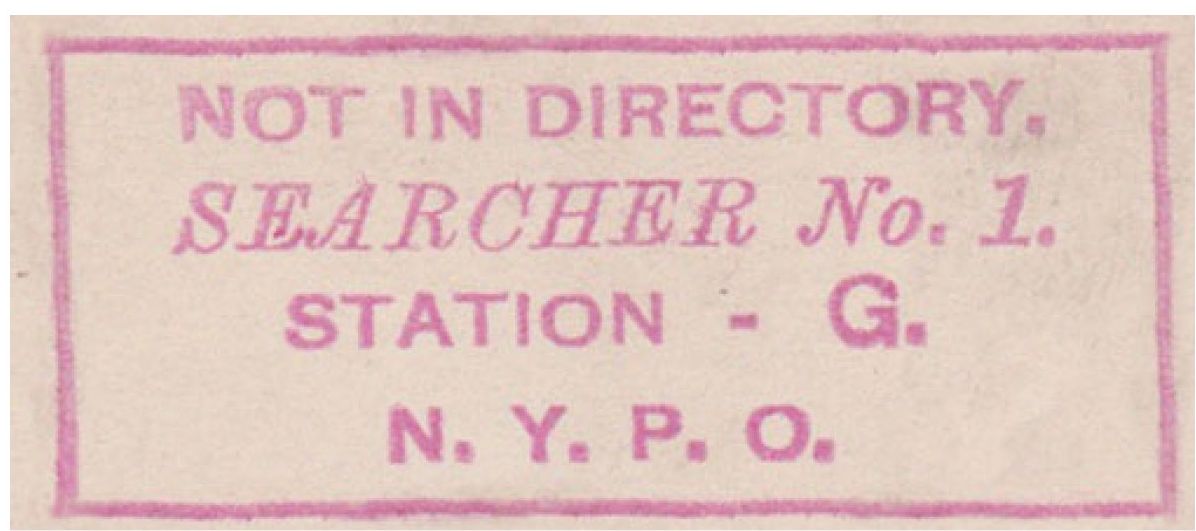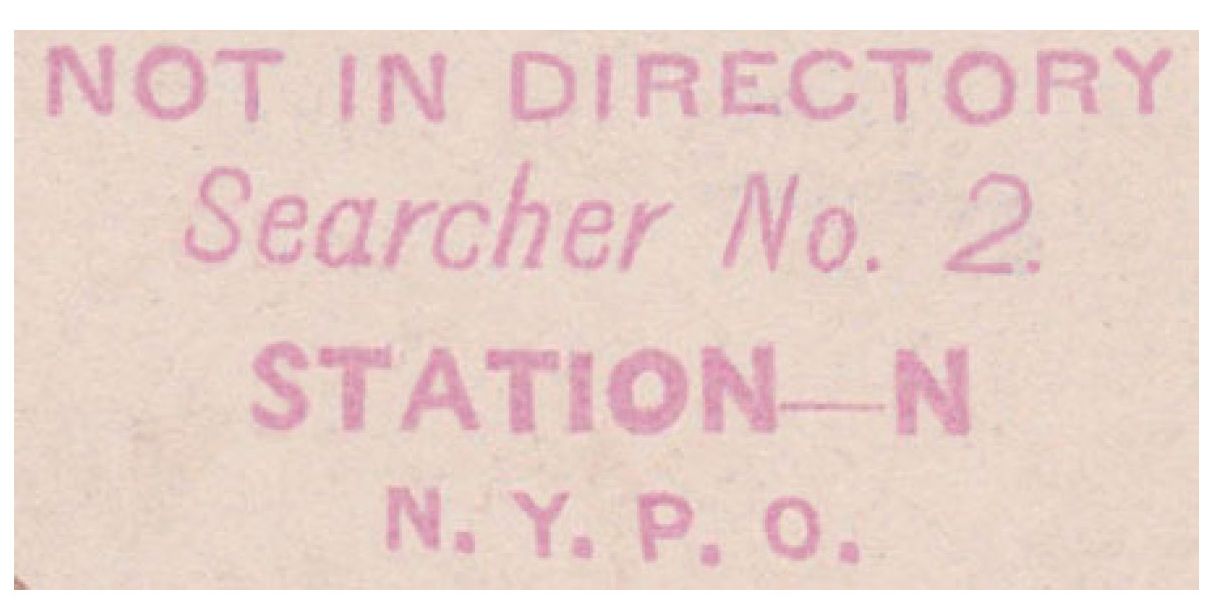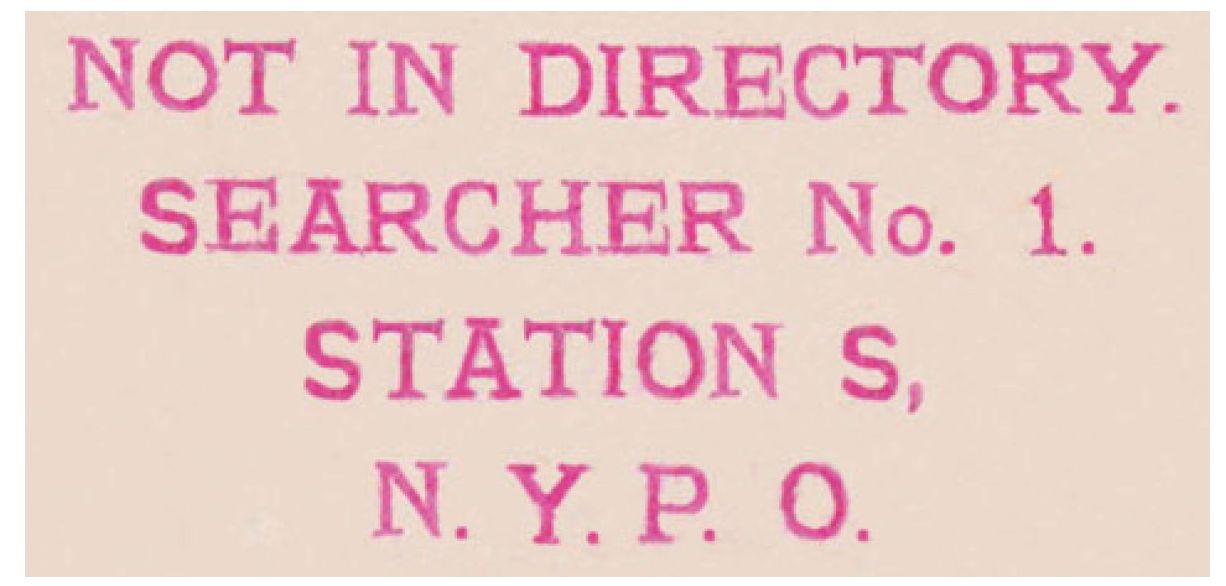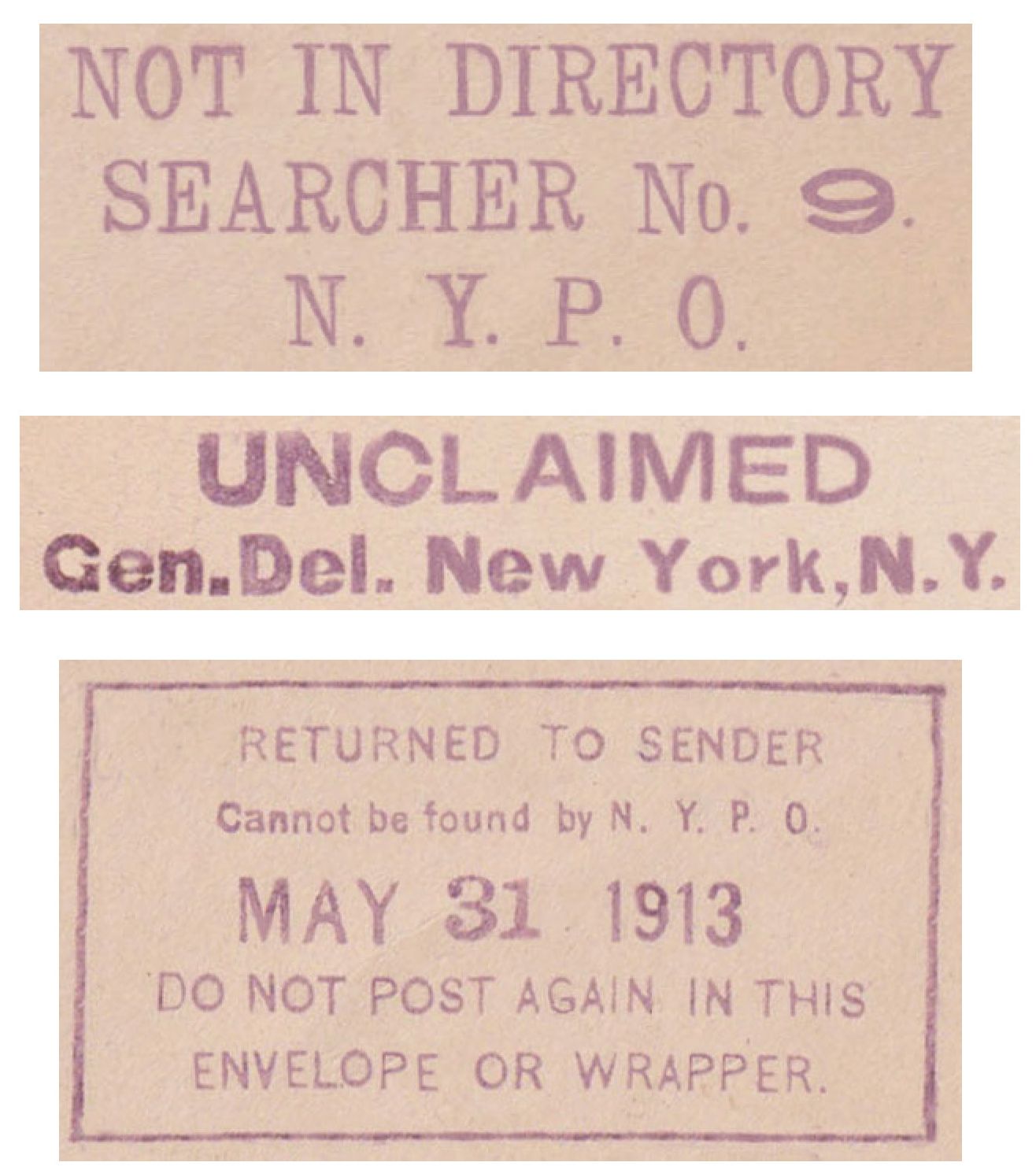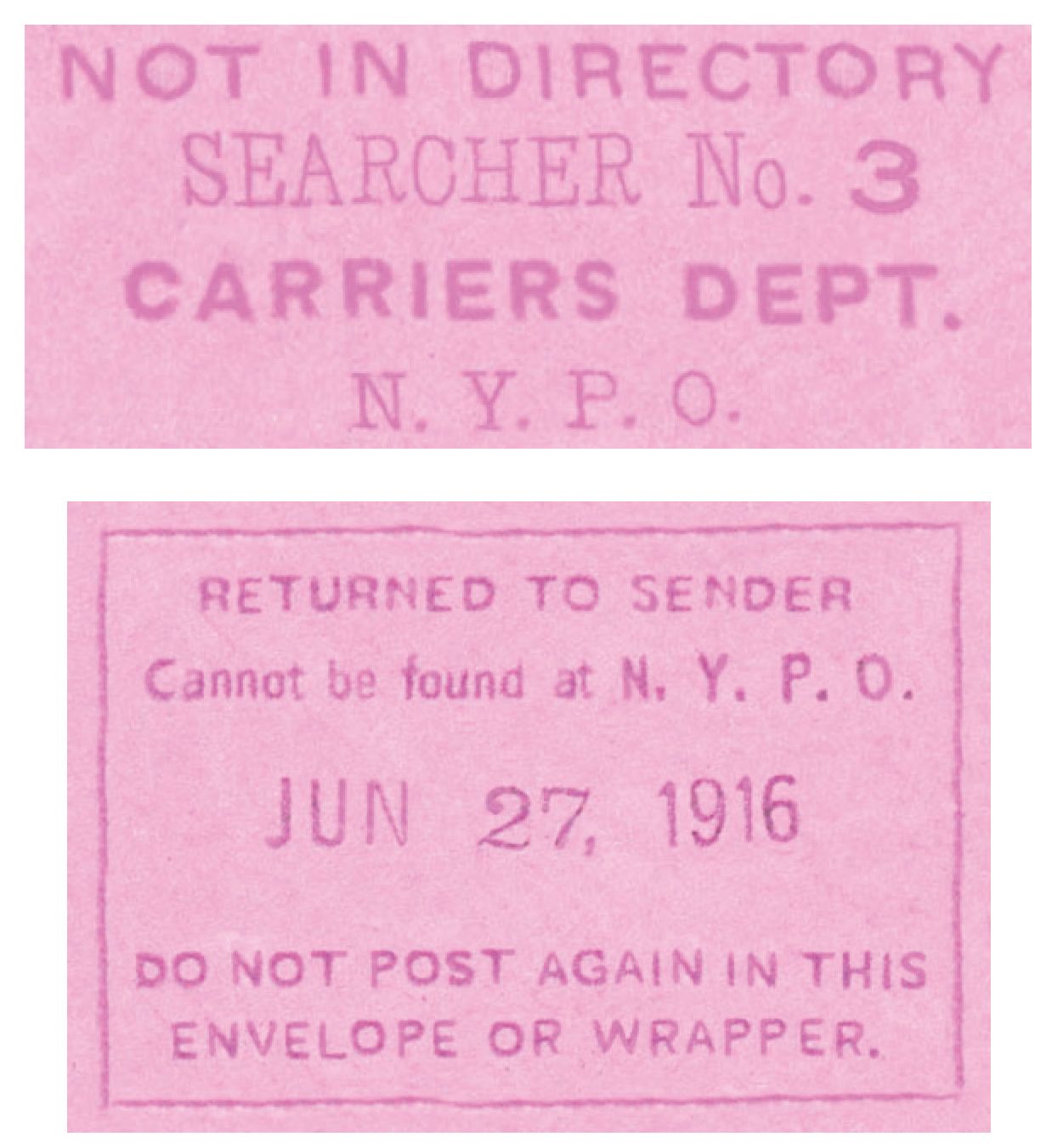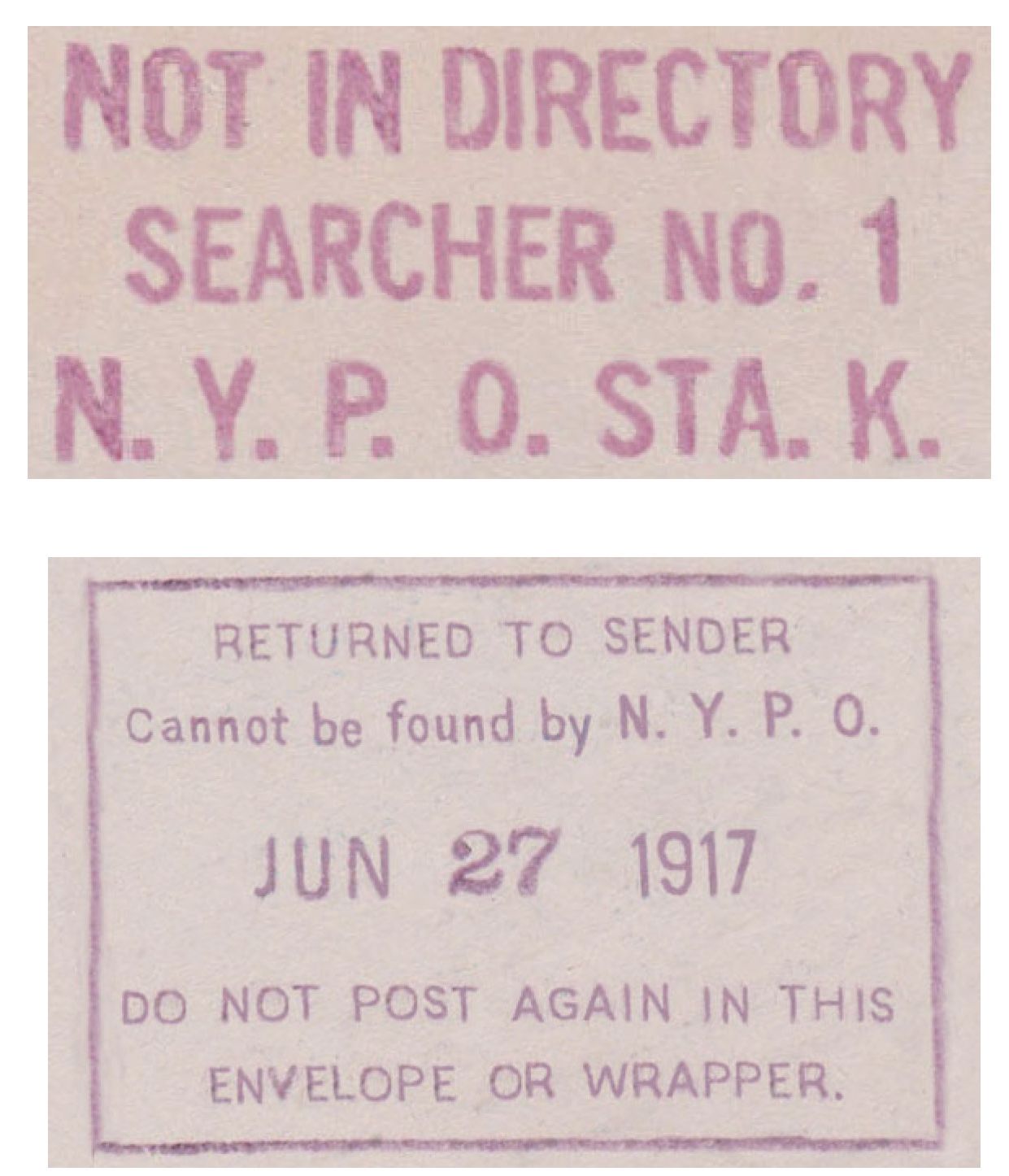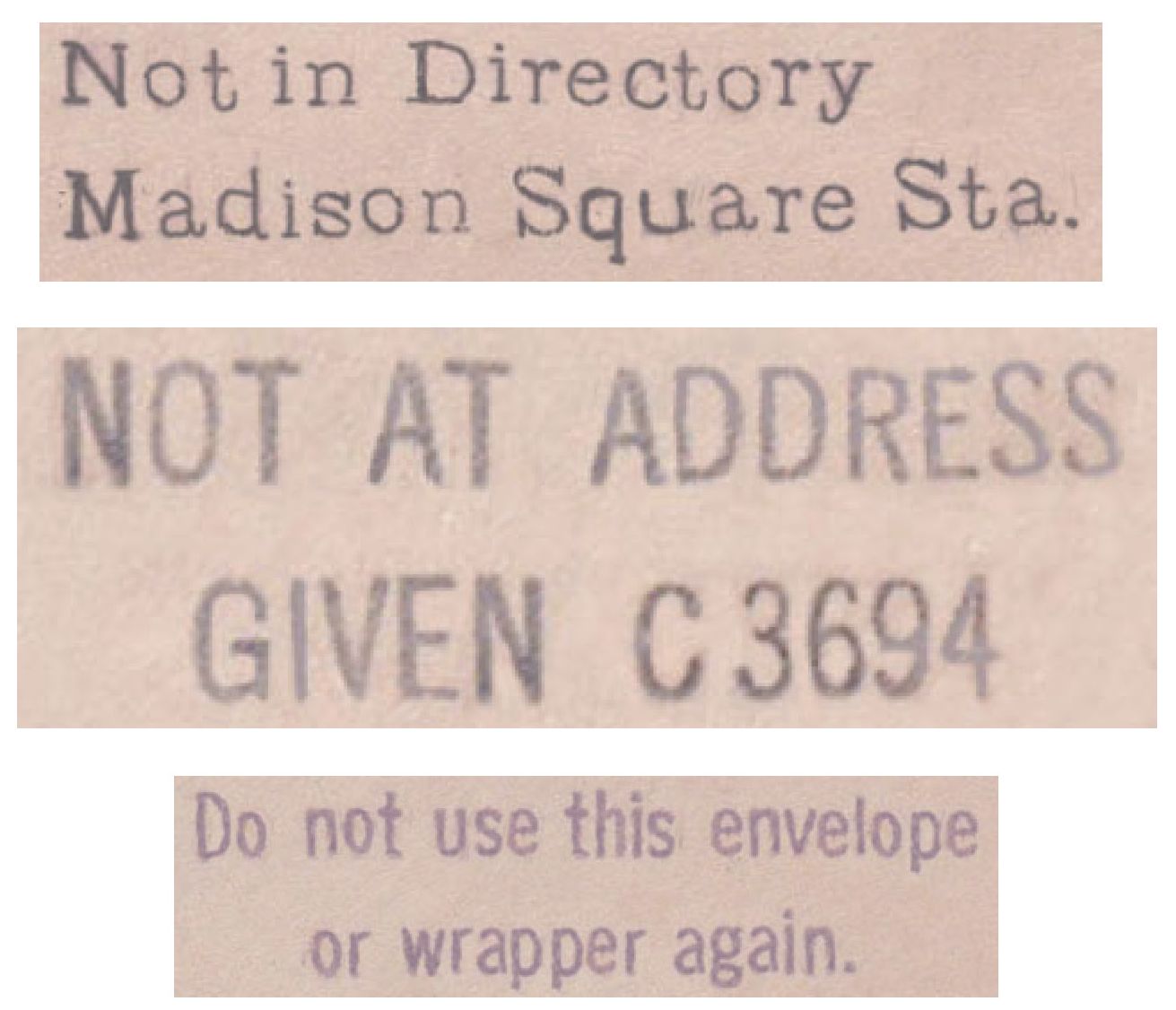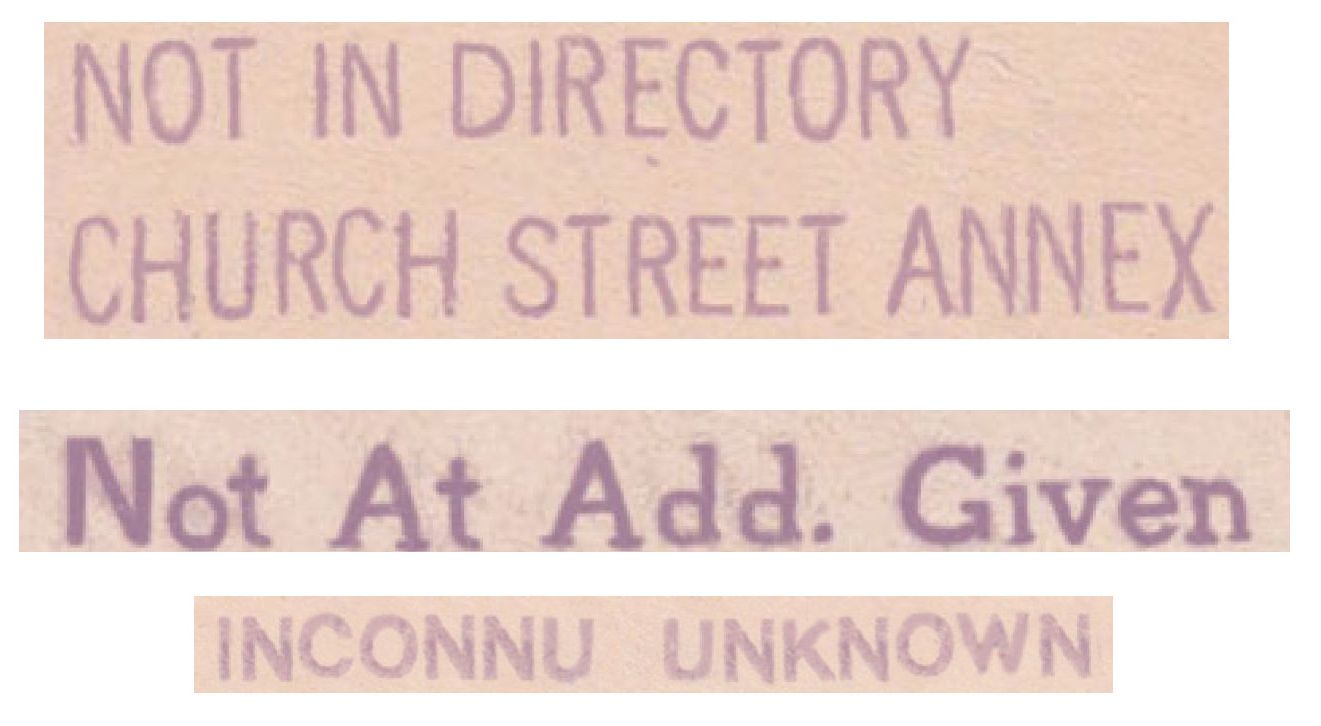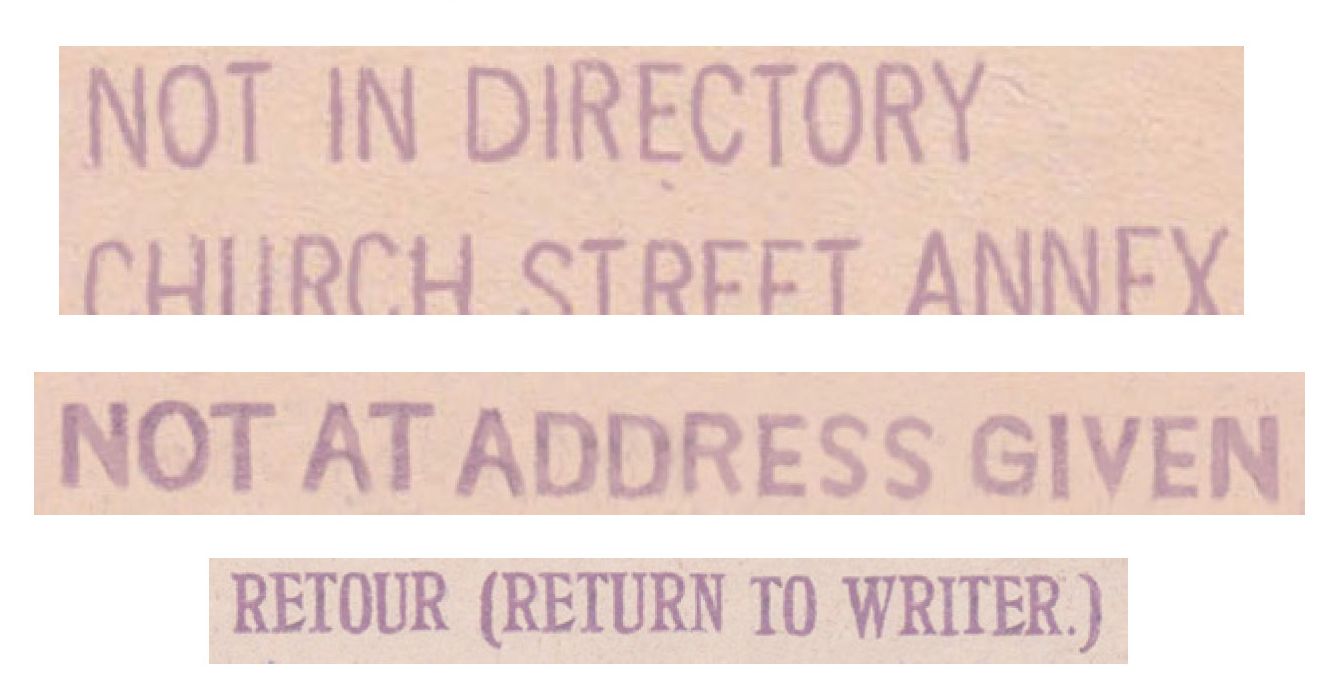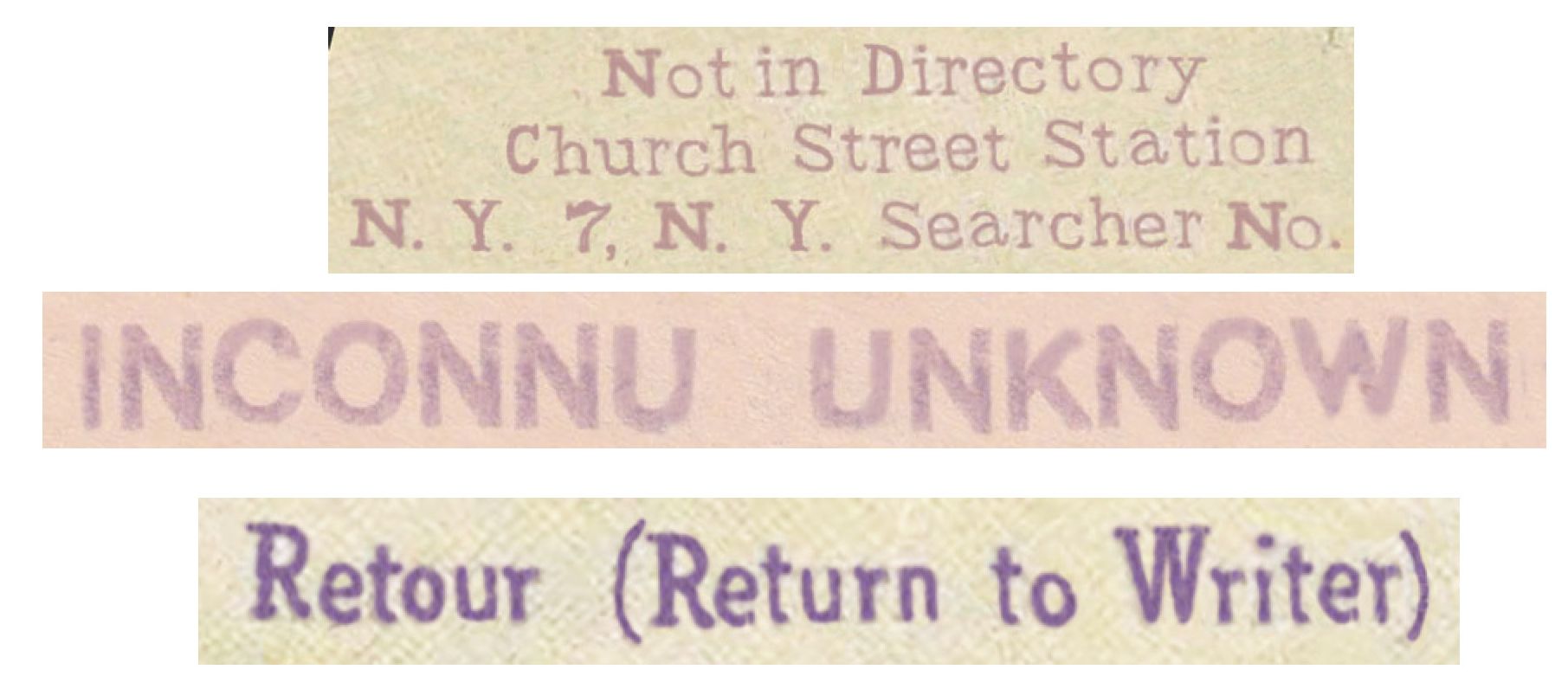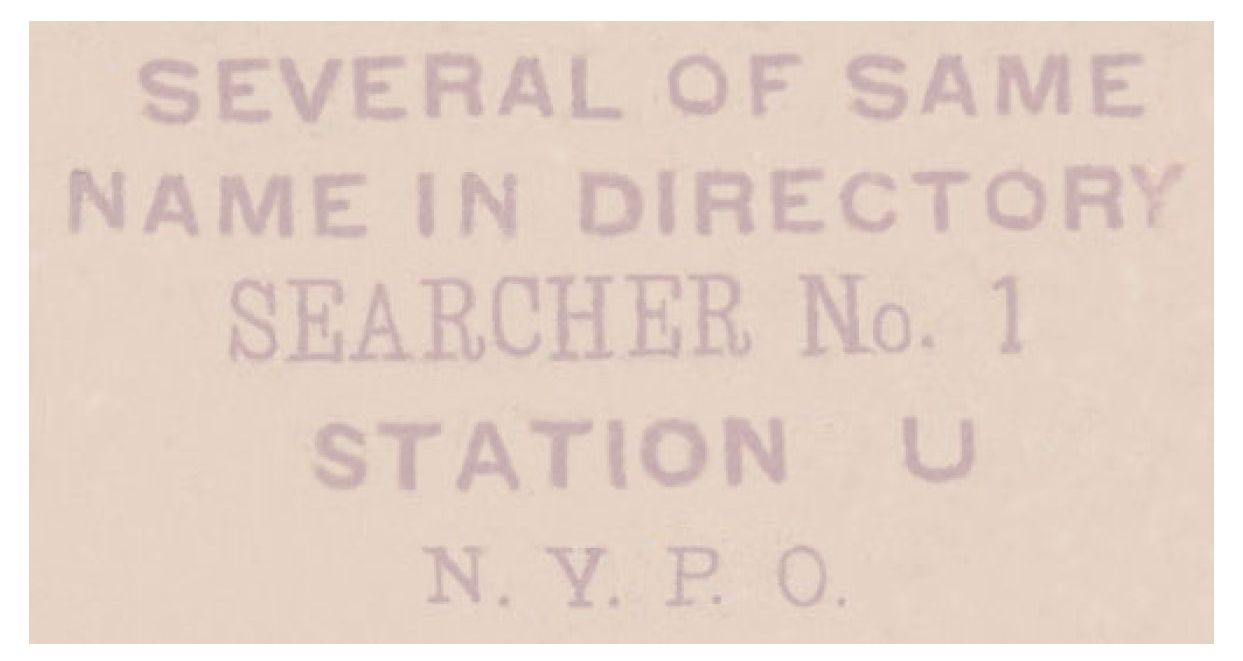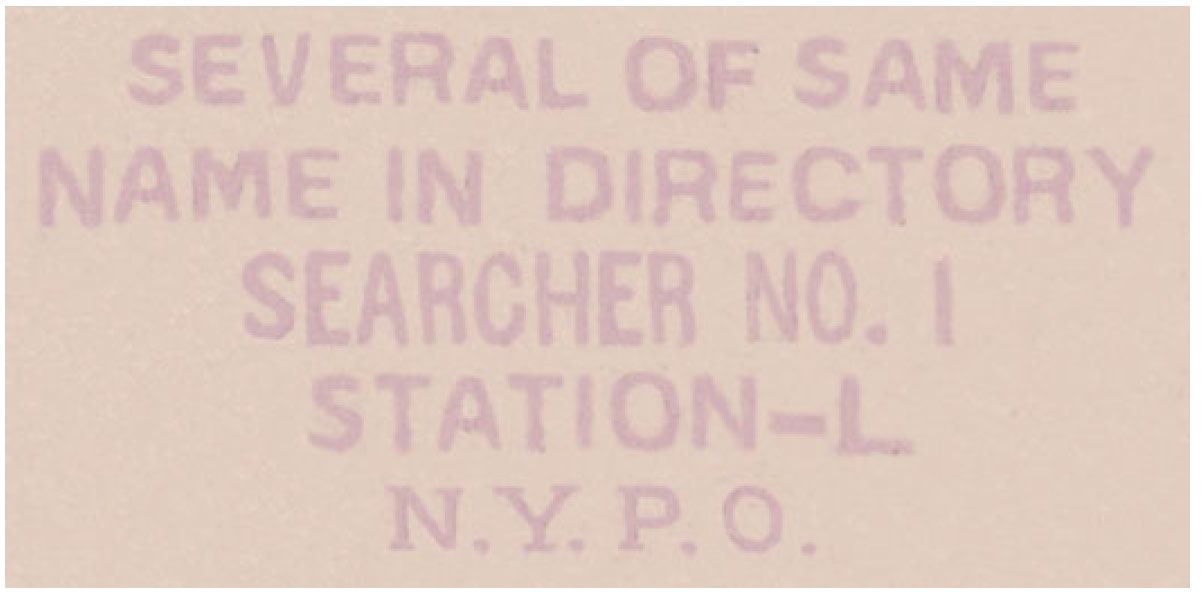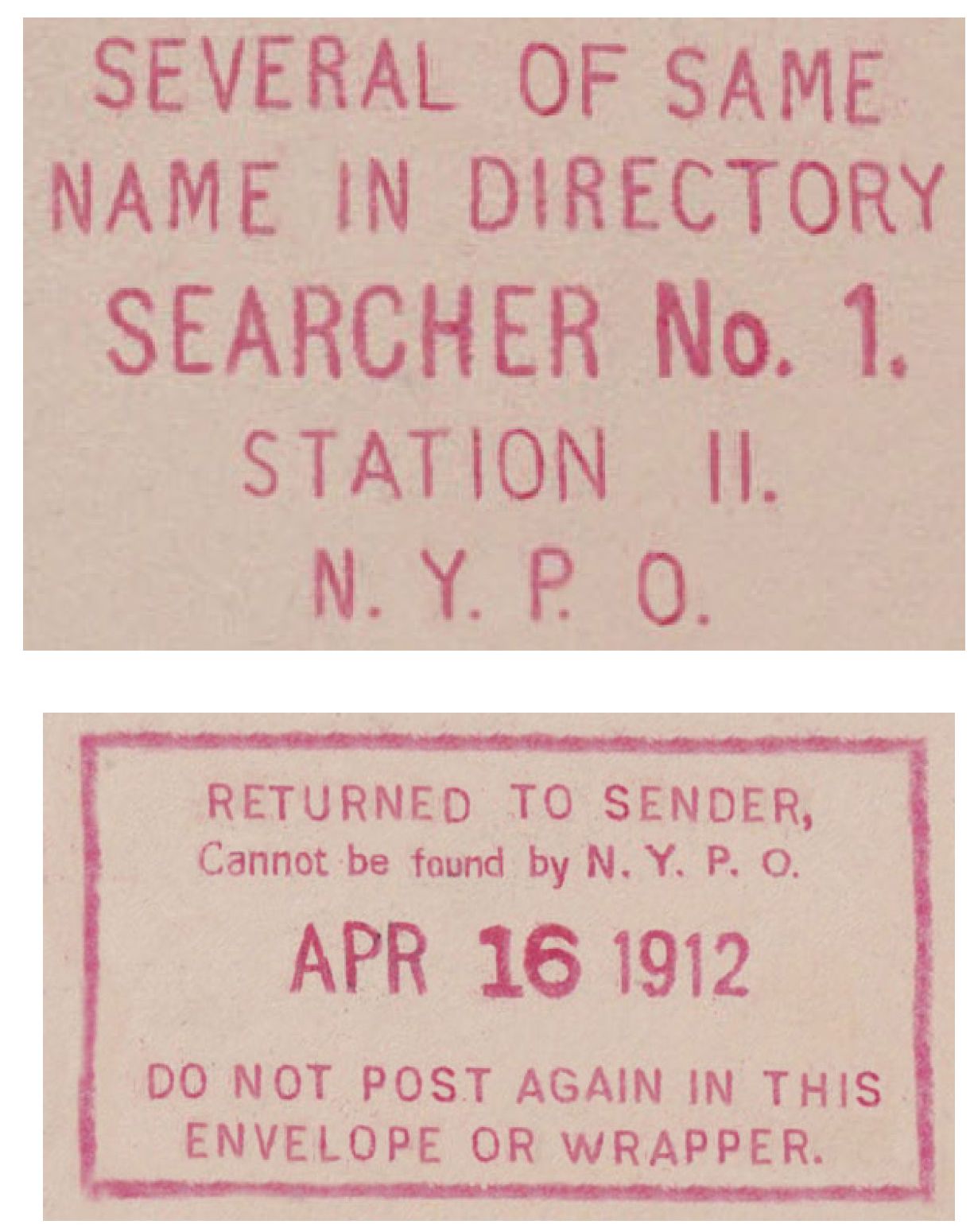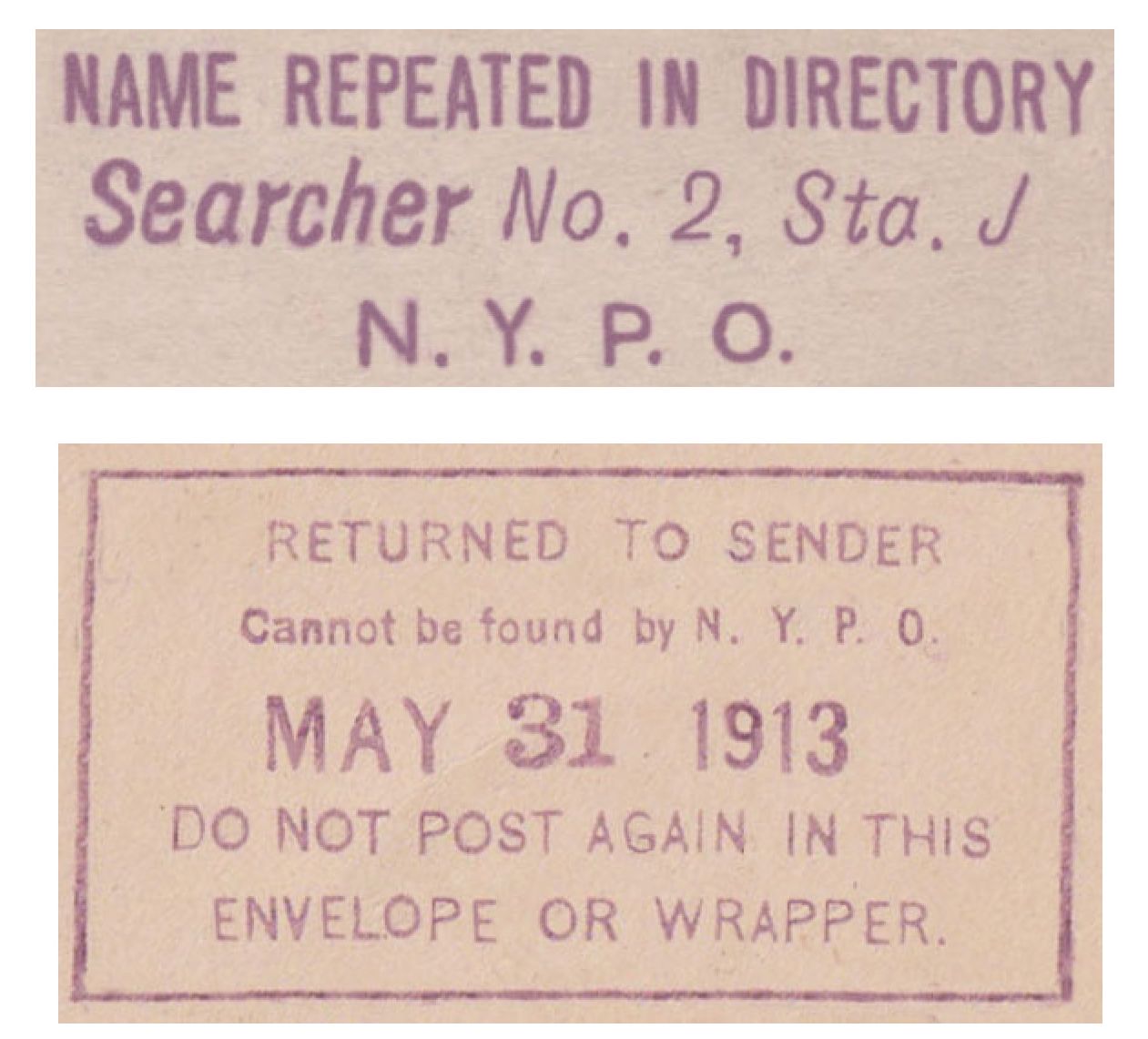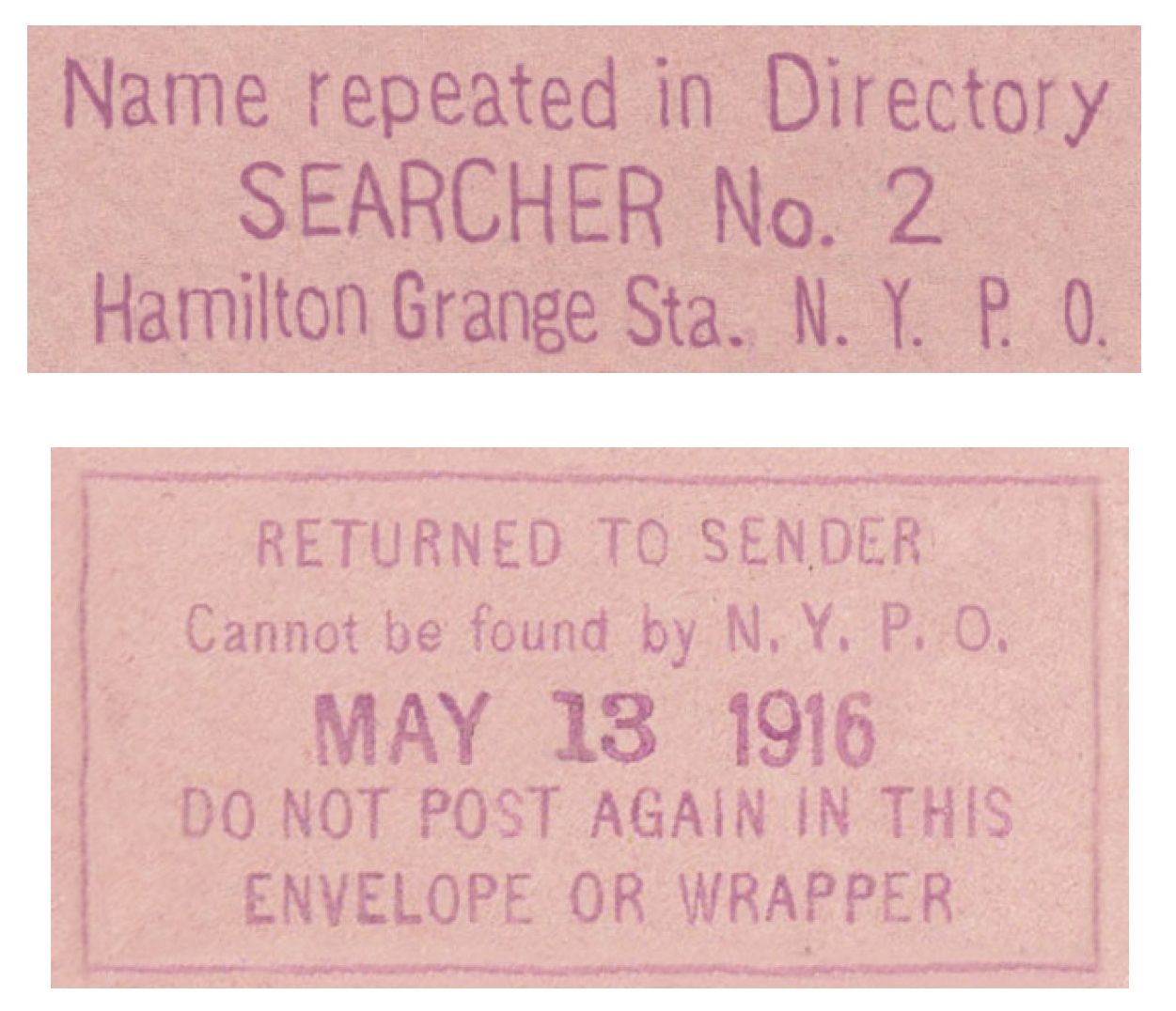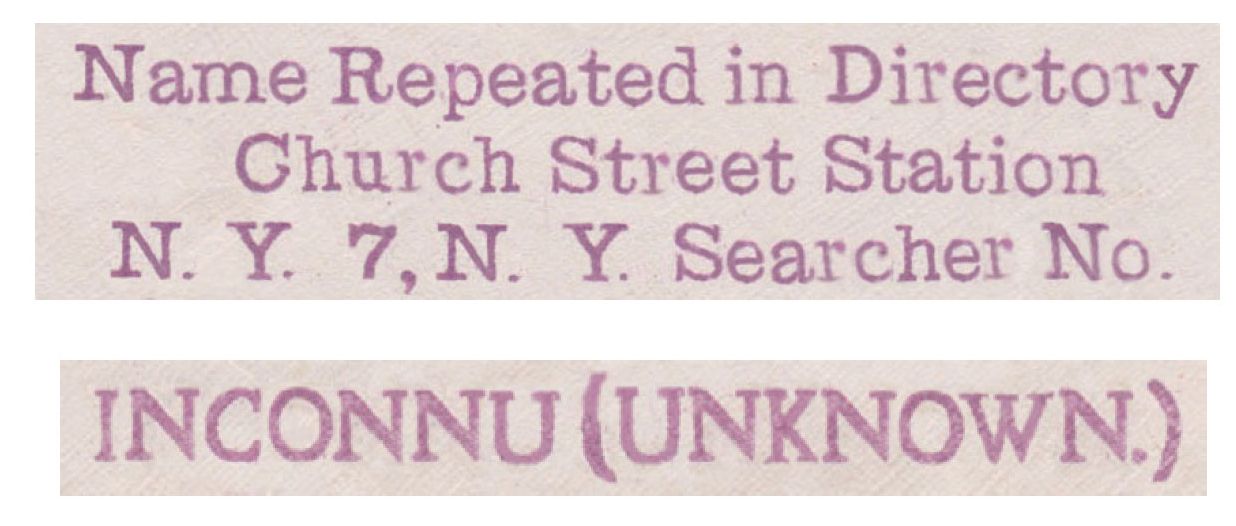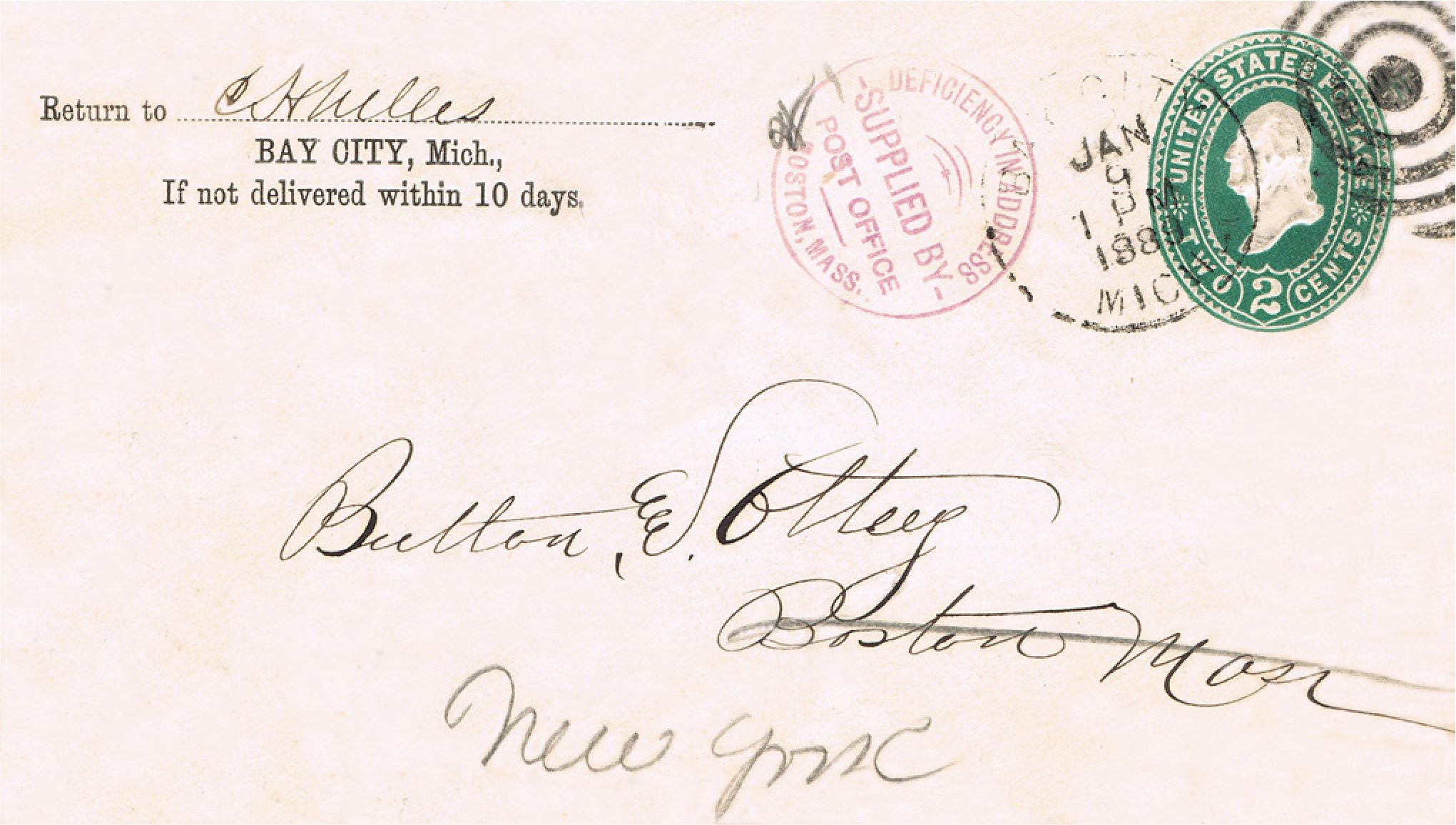
Click On Images Below To See Larger Image
Directory Assistance
in Readdressing
Misdirected Items
By Anthony Wawrukiewicz, Thomas Breske, & Scott Steward
If you have an auxiliary marking you would like considered for inclusion in this or future articles you can contact the authors by using the Stamp Smarter Contact Us form.
Introduction
From 1879 to the present, directories were/are used to
rectify addresses on items that were misdirected because their
addresses were in error. Recent research by Wawrukiewicz
has shown that the rules governing directory use changed
markedly and frequently over time. Among other things, this
article will illucidate these changes.
One of the reoccurring problems encountered by postal
employees in processing and delivering mail through the
history of postal service has been dealing with mail that has
an erroneous address (misdirected). Typical addressing errors
include addresses containing a city but no state or addresses
containing a city and a state but the city is not located in
the state shown in the address. Mail containing these types
of errors is often referred to as Nixies. The January 1886
United States Official Postal Guide, section 417, page 709
defines Nixies as:
The earliest mention of a possible manner in which to handle such misdirected mail matter was found in 1873 Postal Laws & Regulations (PL&R) SEC. 231:
However, this ruling said nothing about placing the
handstamp type that eventually was introduced that reflected this suggestion.
The 1879 PL&R basically reiterated these 1873 comments in Sections 342 and 346:
However, it wasn’t until the November 1884 Supplement to the Postal Guide (PG), on page 18 that we found the following:
That is, it was only here that the handstamp ‘Deficiency in address supplied by ____’, that makes up the majority of the content of this chapter, was introduced officially.
Directory Use for Misdirected Letters in Free-Delivery Cities, both Intra-City and Local Letters
This section introduces the basics of the use of the directories and the associated handstamps for misdirected intra-city and local letters in free-delivery (carrier) cities, only through the early 1950s, because then significant changes in the process occurred. 1887 PL&R Section 563 reiterated, with minor changes, this November 1884 Postal Guide statement:
Note that there is no mention of the relationship of this announcement to a free-delivery post office. The 1893 PL&R Sec. 482, significantly added:
When such mail—which has been treated and forwarded as above provided for—is received from another post-office and the postmaster at the receiving office fails to deliver the same, he will stamp it “misdirected “ and include it with his next regular return of umnallable matter to the Dead Letter Office. In no case will such an article of mail matter be returned to the forwarding office or sent to a new destination unless the postmaster has a proper forwarding order from the addressee.
Figure 1. - Dec. 1879 pre-official-announcement card misdirected from
Elgin, Iowa to Chicago, Ill.
There it was redirected to Troy, N.Y. (Len
Piszkiewicz Collection)
This latter 1893 PL&R announcement is important
because it mentions that the ruling applied to free-delivery
post offices. That is, it would apply to misdirected intra-city
and local letters of such post offices (Bold lettering added
by authors for emphasis).
The first three examples in this chapter used the handstamp
mentioned in the above announcements, but before these
official announcements. In Figure 1 is an early pre-official announcement
(Dec. 1879) card misdirected from Elgin,
Iowa to Chicago, Ill. There it was redirected to Troy, N.Y.
This is the earliest known-to-the-authors pre-official use of
the handstamp ‘DEFICIENCY IN DIRECTION SUPPLIED
BY...’, followed by the post office name, CHICAGO in this
case. Note that cover illustrations in this article are shown
reduced in size, but the handstamps are illustrated actual size.
Figure 2. April 1880 pre-official-announcement letter misdirected
from Albany, N.Y. to New York City.
It was then redirected there
with the appropriate handstamp to Syracuse. (Tom Breske Collection)
Figure 2 shows the use of yet another pre-announcement
Deficiency...’ marking. This letter is an 1880 (cancels on
the cover’s reverse) letter misdirected from Albany N.Y, to
New York City. In New York City it was redirected with the
appropriate ‘DEFICIENCY IN DIRECTION SUPPLIED BY
NEW YORK POST OFFICE’ handstamp to Syracuse, N.Y.
Note that, in the experience of the authors, these pre-official
announcement uses of the handstamp are not that unusual,
and probably represent experimental uses.
Figure 3. July 1882 (enhanced circular date stamp) pre-officialannouncement letter misdirected from Sulfur Springs, Tex. via Greenville, Tex. (30 miles apart) to St. Louis. It was then redirected there with the appropriate handstamp to Cincinnati, Ohio. (Scott Steward Collection)
The final pre-official-announcement item is shown in Figure 3. This figure illustrates a July, 1882 letter from Sulfur Springs, Texas, via Greenville, Texas (30 miles distant), misdirected to St. Louis. There it was redirected with the appropriate ‘DEFICIENCY IN DIRECTION SUPPLIED THE ST. LOUIS P.O.’ handstamp to Cincinnati, Ohio. Note that all three of these early handstamps were used in large cities and used the word ‘DIRECTION’ in their format.
Figure 4. Jan. 1889 post-official-announcement letter misdirected from Bay City, Mich. to Boston. It was then redirected there with the appropriate handstamp to New York City. (Scott Steward Collection)
As mentioned before, the experimental period of the use of the ‘Deficiency...’ handstamp, apparently used in large cities, ended with an announcement in the Nov. 1884 supplement to the Postal Guides. In Figure 4 is a Jan. 1889 post-officialannouncement letter misdirected from Bay City, Mich. to Boston. Mass. It was then redirected there with the appropriate handstamp to New York City. Note that henceforth, the word ‘DIRECTION’ in these handstamps was replaced by the word ‘ADDRESS.’
Figure 5. March 1893 post-official-announcement letter misdirected from France to Portland, with no state given in the address. It was then redirected there with the appropriate handstamp to the correct state of Maine. (Scott Steward Collection)
Up to now the misdirected letters were all domestic letters. However, frequently, the misdirection was on an international letter like the one in Figure 5. Such foreign letters often passed through exchange cities, including New York City. This March 1893 postofficial- announcement letter was misdirected from France to Portland, with no state given in the address. It was then redirected in the exchange city NYC with the appropriate handstamp to the correct state of Maine. As was typical of early NYC handstamps, the post office had a complex name, in this case the 3rd Div. NYC post office.
The next example of a directory-handled letter shows two important variants in this process. First, the letter was a local letter addressed within NYC, and the directory search was done, but was unsuccessful. As mentioned before, at the time, misdirected local free-delivery letters were allowed directory assistance. We’ll see that this changed as of Nov. 29, 1937 (PB 17322).
Figure 6. May 1916 post-official-announcement local NYC letter misdirected as ‘Name repeated in Directory / Searcher No. 2 / Hamilton Grange Sta. N. Y. P. O.’ That is, directory assistance was performed, but it was unsuccessful. (Tom Breske Collection)
In Figure 6 above is a May 1916 local (non-carrier) NYC letter that was misdirected and could not be delivered because ‘Name repeated in Directory / Searcher No. 2 / Hamilton Grange Sta. N. Y. P. O.’ That is, directory assistance was performed, but it was unsuccessful.
The final two examples of directory assistance in this section again illustrate the use of the directory for misdirected items in free delivery cities. These two examples are a domestic and international misdirected item, both in smaller cities, later in the time period.
Figure 7. 1932 letter misdirected? from Watsonville to Santa Cruz, Calif. For reasons that are unclear, ‘Directory Service Given / Santa Cruz, California.’ The authors say unclear because the letter was not obviously misdirected as it was undeliverable to the addressee ‘Moved / Left no address.’ (Tom Breske Collection)
The first, in Figure 7 above, is a 1932 misdirected Watsonville to Santa Cruz, Calif. letter. For reasons that are unclear, ‘Directory Service Given / Santa Cruz, California.’ The authors say unclear because the letter was not obviously misdirected as it was undeliverable to the addressee ‘Moved / Left no address.’
Figure 8. 1938 letter misdirected from France to Wilmington, Delaware. It was then redirected there with the appropriate handstamp to the correct destination of Dover, Delaware. (Tom Breske Collection)
In Figure 8 above is a 1938 letter misdirected from France to Wilmington, Delaware. It was then redirected there with the handstamp ‘DEFICIENCY IN ADDRESS SUPPLIED BY WILMINGTON, DEL.’ to the correct destination of Dover, Delaware.
None of the authors have seen an example of such a directory use. For that matter, examples of such directory use for a local freedelivery letter, such as illustrated in Figure 6, are felt, by the authors, to be almost as scarce.
Directory Use for Misdirected Letters in Non-Free-Delivery Cities, Local Letters Only
As noted earlier, from 1893 to Nov. 29, 1937, misdirected local letters in free-delivery cities could and were given directory assistance where needed. What about misdirected non-free delivery local letters? New in 1902 PL&R, Section 629 - 3 was:
So as of this PL&R, misdirected local letters in nonfree- delivery offices were to be given directory service. This remained true only until the PB 10773 (JUNE 25, 1915):
None of the authors have seen an example of such a directory use. For that matter, examples of such directory use for a local freedelivery letter, such as illustrated in Figure 6, are felt, by the authors, to be almost as scarce.
Directory Use for Misdirected Letters in Free-Delivery Cities for Local Letters Only
Similar to what we found for directory service for misdirected local letters in non-free-delivery cities, eventually such service was not given for misdirected free-delivery local letters. Specifically PB 17322 of Nov. 29 1937 stated for letter-carrier (free-delivery) offices:
Figure 9. Nov. 1932 misdirected local Tacoma (free-delivery post office) letter. As local free-delivery letter, ‘NOT GIVEN DIRECTORY SERVICE.’ (Marjorie Sente Collection)
Before this regulation was stated officially in 1937, there existed examples of this new regulation, one which is shown in Figure 9 above. In this figure is a Nov. 1932 misdirected local Tacoma (free-delivery post office) letter. As a local free-delivery letter, ‘NOT GIVEN DIRECTORY SERVICE.’
Figure 10. Feb. 1942 misdirected local Tacoma (free-delivery post office) letter. As local free-delivery letter, ‘Not Givcn Directory Service.’ This letter was mailed after the official new regulation was announced, and carries a different hs than seen in Figure 9. (Tony Wawrukiewicz Collection)
The next letter, in Figure 10 above, was mailed after the new regulation was promulgated. In this figure is another Tacoma Feb. 1942 misdirected local (free-delivery post office) letter. As local free-delivery letter, ‘Not Givcn Directory Service.’ Note that this letter carries a different hs than seen in Figure 9.
Post-April 18, 1950 Final Changes in How Directory Service was Given for Misdirected Items.
Before April 18, 1950, as found earlier in this article,
depending on the rules and regulations that were in effect,
when a mailed item carried an inadequate address so that it
was undeliverable, post office department (POD) workers
would make every reasonable effort to correct the address
so that the item was deliverable. In fact, there were large
directories for all the major cities that could be used to help
the workers make these address corrections. These efforts
were time-consuming, and finally the POD made the decision
that some such efforts were no longer feasible. So, in
what follows, we find the development of a series of rules
and regulations concerning when directory service was now
to be given.
On April 18, 1950, in Postal Bulletin 19327, we find the
following announcement:
This was added to by PB 19339 (June 1, 1950):
Therefore, occasionally, even after the early 1950s, as we will show in what follows, some domestic letters not enumerated in these new rules and regulations were given address correction service of some type. Further, we find in PB 19574 (Sept. 23, 1952):
That is, this statement essentially reiterates the message of the prior PB announcement. Again, examples follow. Then, in PB 19611 (Feb. 17, 1953) was stated:
Finally, in Post Offices Circular 1 (Oct. 18, 1954) was added:
What follows are a total of six items that followed these new rules and regulations. The first two are examples of misdirected incoming international items that were correctly given directory service.
Figure 11. Dec. 1955 letter misdirected from Trinidad to Keen Tacts. Somehow it arrived in Cincinnati, Ohio where, correctly using a directory, with an appropriate hs, it was redirected to Keene, Texas. Obviously, the sender had no idea of how to spell the original address. (Tom Breske Collection)
In Figure 11 is a Dec. 1955 letter misdirected from Trinidad to Keen Tacts (sic). Somehow it arrived in Cincinnati, Ohio where, correctly using a directory, with an appropriate hs, it was redirected to Keene, Texas. Obviously, the sender had no idea of how to spell the original address, but fortunately a Cincinnati postal worker did.
Figure 12. Dec. 1961 post card misdirected from Germany to Jonestown, with no state given. New York City must have operated as an exchange city because NYC correctly used a directory and discovered that the correct address state was Penn. NYC then placed the correct hs and state name on the post card, and it was delivered. (Tom Breske Collection)
In Figure 12 is a Dec. 1961 post card misdirected from Germany to Jonestown, with no state given in the address. New York City must have operated as an exchange city because NYC correctly used a directory and discovered that the correct address state was Penn. NYC then placed the correct hs and state name on the post card, and it was delivered.
Next are shown two examples of misdirected domestic
letters where handstamps placed indicate that directory assistance
was not given, and apparently, no other correction
was possible.
Figure 13. March 1955 domestic misdirected letter (‘INSUFFIENT ADDRESS’) from Yakima to Peoria. Peoria indicated that ‘DIRECTORY SERVICE DISCONTINUED,’ and so none was given. (Tony Wawrukiewicz Collection)
In Figure 13 is a March 1955 domestic misdirected letter (‘INSUFFIENT ADDRESS’) from Yakima to Peoria. Peoria indicated that ‘DIRECTORY SERVICE DISCONTINUED,’ and so none was given.
Figure 14. Dec. 1965 domestic misdirected letter from Highland Park, N.J. to New York City was (‘RETURNED FOR BETTER ADDRESS’). NYC indicated that ‘DIRECTORY SERVICE DISCONTINUED.’ No other method to correct the inadequate address was apparently possible either, so the letter was returned to the sender. (Tony Wawrukiewicz Collection)
The Dec. 1965 domestic misdirected letter in Figure
14, from Highland Park, N.J. to New York City was (‘RETURNED
FOR BETTER ADDRESS’). NYC indicated that
‘DIRECTORY SERVICE DISCONTINUED.’ No other method
to correct the inadequate address was apparently possible
either, so the letter was returned to the sender.
The last two examples of misdirected mail matter are
domestic items where the address correction that was made
only required the knowledge of the postal worker, not the
use of a directory.
Figure 15. Sept. 1959 post card from Seattle to Lebanon, Ind. In Seattle, a post office worker had difficulty reading the state name. Therefore, without needing directory assistance, a Seattle worker corrected the address by writing out the state name (Indiana). The Seattle worker then placed the correct hs and the card was delivered. (Tom Breske Collection)
In Figure 15 is a Sept. 1959 post card from Seattle to Lebanon, Ind. where the post office had difficulty reading the state name. Therefore, without needing directory assistance, a Seattle postal worker corrected the address by writing out the state name (Indiana). The Seattle worker then placed the correct hs and the card was delivered.
Figure 16. May 1960 letter from Philadelphia to Grinnell, Iowa. In Philadelphia, a postal worker felt that the city of address was poorly written, and so wrote it out more clearly. He then correctly placed the correct hs on the letter, and it was delivered. (Tom Breske Collection)
In Figure 16 is a May 1960 letter from Philadelphia to
Grinnell, Iowa. In Philadelphia, a postal worker felt that the
city of address was poorly written, and so wrote it out more
clearly. He then correctly placed the correct hs on the letter,
and it was delivered.
So, the address corrections of the last two somewhat
poorly addressed items required only the astute efforts of
postal workers, without any directory assistance.
Conclusion
Thus ends the introduction of the somewhat complex history of the allowed use of various types if assistance in correcting misdirected mail into U.S. cities. We now illustrate the New York City (NYC) examples known for this process. These are shown without the associated misdirected letters, although their use on the items are explained, if possible. If the initials ‘as’ are part of the description, this means that the hs is illustrated actual size. It is interesting to us authors that in the case of incoming foreign letters, in correcting misdirected letters from other countries, that NYC often acted as an exchange office.
The hs in Figure 16 again shows the earliest known (to
the authors) NYC ‘Deficiency...’ hs. This was on a April 1880
letter misdirected from Albany, N.Y. to NYC. There it was redirected
to Syracuse, N.Y. with the hs illustrated. It was used
before the official announcement of the rules and regulations
announcing it, and only for these pre-announcement items the
word “DIRECTION’ was used in these hs.
In Figure 18 is an 1898 NYC hs from a misdirected
post card from Germany to NYC. There it was redirected to
Moundsville, W.Va. with the NYC hs illustrated. The directory
assistance was necessary because the address was done
in faint pencil. NYC presumably acted as an exchange city.
In Figure 26 is a NYC hs from a 1915 misdirected letter
from Italy. NYC apparently acted as an exchange city. In
NYC it was redirected to Lehighton, Penn. with the hs illustrated.
Once there it was forwarded to Bloomsburg, Penn.,
then Hutchinson, Kansas, where it was finally delivered.
New York City ‘Deficiency...’ - Related Markings without the Associated Letters, etc.
There were other auxiliary markings related to the use of directories that are now presented chronologically. The first group below are markings that evaluated addresses where the addressee was not in the directory.
In Figure 39 is a 1913 NYC hs from a domestic Providence,
R.I. to NYC misdirected letter with return address
(CC). In NYC, item was found to be ‘NOT IN DIRECTORY’
and ‘UNCLAIMED.’ As undeliverable with CC, RETURNED
TO SENDER’ ‘DO NOT POST AGAIN IN THIS ENVELOPE
OR WRAPPER.’
In Figure 40 is a 1916 NYC hs from a domestic local
NYC misdirected letter with return address (no CC). In
NYC, item was found to be ‘NOT IN DIRECTORY’ (undeliverable).
As undeliverable with CC, RETURNED TO
SENDER’ ‘DO NOT POST AGAIN IN THIS ENVELOPE
OR WRAPPER.’
In Figure 41 is a 1915-7 NYC hs from a domestic Mercersburg,
Penn. to NYC misdirected letter with return address
(CC). In NYC, item was found to be ‘NOT IN DIRECTORY.’
As undeliverable with CC, RETURNED TO SENDER’ ‘DO
NOT POST AGAIN IN THIS ENVELOPE OR WRAPPER.’
In Figure 43 is a 1943 NYC hs from a domestic Orlando,
Fla. to NYC misdirected letter with return address (CC). In
NYC, addressee was found to be ‘NOT IN DIRECTORY’
and ‘NOT AT ADDRESS / GIVEN.’ As undeliverable with
CC, ‘RETURNED TO SENDER’ ‘Do not use this envelope
or wrapper again.’
In Figure 46 is a 1955 NYC hs from an India to NYC
misdirected letter with return address (CC). In NYC, addressee
was found to be ‘NOT IN DIRECTORY’ and ‘INCONNU
UNKNOWN.’ As undeliverable with CC, ‘Retour (Return to
Writer.’ As post-1954 international letter, directory service
correctly given.
The second group of auxiliary markings related to the use
of directories that evaluated addresses where the addressee’s
name was repeated in the directory. The first example known
for NYC is illustrated in Figure 47.
In Figure 47 is a local 1906 NYC hs from Brooklyn to
NYC, a domestic misdirected post card without a return address
(no CC). In NYC, item was found to be undeliverable
after a directory search as ‘SEVERAL OF SAME / NAME
IN DIRECTORY.’ As undeliverable without CC, not returned
to writer.
In Figure 48 is a 1910 NYC hs from Babylon, N.Y, to
NYC, a domestic misdirected post card without a return address
(no CC). In NYC, item was found to be undeliverable
after a directory search as ‘SEVERAL OF SAME / NAME
IN DIRECTORY.’ As undeliverable without CC, not returned
to writer.
In Figure 49 is a local 1912 NYC hs from a domestic
Brooklyn, N.Y. to NYC misdirected letter with return address
(CC). In NYC, item was found to be ‘SEVERAL OF SAME
/ NAME IN DIRECTORY.’ As undeliverable with CC, RETURNED
TO SENDER’ ‘DO NOT POST AGAIN IN THIS
/ ENVELOPE OR WRAPPER.’
In Figure 50 is a 1913 NYC hs from a domestic Proctorsville,
Ver. to NYC misdirected letter with return address
(CC). In NYC, item was found to be ‘NAME REPEATED IN
DIRECTORY.’ As undeliverable with CC, RETURNED TO
SENDER’ ‘DO NOT POST AGAIN IN THIS / ENVELOPE
OR WRAPPER.’
In Figure 51 is a 1916 NYC hs from a domestic local
NYC misdirected letter with return address (CC). In NYC,
item was found to be ‘Name Repeated in Directory.’ As undeliverable
with CC, RETURNED TO SENDER’ ‘DO NOT
POST AGAIN IN THIS / ENVELOPE OR WRAPPER.’
In Figure 52 is a 1954 NYC hs from a Canada to NYC
misdirected letter with return address (CC). In NYC, item was
found to be ‘Name Repeated in Directory.’ As undeliverable
with CC, ‘INCONNU (UNKNOWN.)’ so returned to sender.
As internatioal letter in 1954, directory assistance allowed.
